Boat Profile
A Stevenson project
From Issue Small Boats Annual 2021 March 2020
T he Weekender is a plywood gaff-sloop pocket yacht designed by Peter Stevenson and first presented to the public in a two-page article in the March 1981 issue of Popular Science magazine. In the decades that have followed, it has been a very popular design. I was drawn to its classic look and simple construction. Eager to learn how to sail—and to find out if my wife would enjoy sailing too—I was excited about the journey of the build and encouraged by the many helpful examples of other builders who are linked to the Stevenson website.
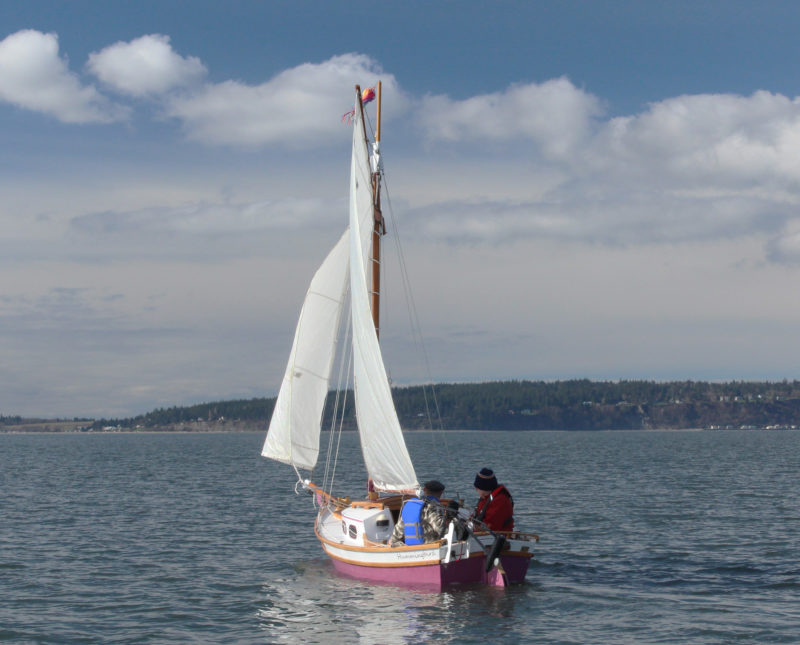
The Weekender draws 3′ with the rudder deployed; with its blade retracted, the hull draws 1′.
I bought the set of plans and the two companion DVDs. The combination of the 44 printed pages and three-and-a-half hours of video were helpful, entertaining, and, above all, encouraging. The plans are well illustrated with some photos and many nice drawings. There are no full-sized patterns, so each part is drawn right onto the materials. Step-by-step instructions keep the process going in the correct order. As a shipbuilder, I found the instructions clear and straightforward. My granddaughter, who was three years old when we started and nearly seven when we finished, was as eager to build the boat as I was, and we watched the video instructions several times together. Even at her young age, she could recognize the steps we had completed and the ones we had yet to accomplish, a good indication of how easy the plans were to follow. For me, the video clarified the few places in the plans that I was having difficulty understanding. Mike Stevenson, Peter’s son, who took over the business, has assured me that the most recent revision has eliminated some of those sticking points.
The Weekender has a very unusual construction: it is built right-side up with the stem and keel serving as the strongback. The deep keel and its integral stem are made of three laminates of 4/4 pine, fir, or mahogany. The keel, 10″ at its deepest, is rigid enough to support the build. I built a cradle to hold it upright throughout the build. Plywood is joined with butt plates to get the necessary length and width for the bottom panel; the bottom is attached to keel with screws and epoxy. The deck is added and secured at the stem and then temporarily propped up until the transom and three bulkheads are installed. The side panels go on next and they’ll extend above the deck to become part of a toerail. The construction then follows a more common sequence, with the assembly of the cockpit and the cabin. The hull, deck, cockpit, and cabin are sheathed with 6-oz fiberglass and epoxy.
The plans indicate a solid mast, and I built mine as per the instructions; however, a lighter hollow version would be much easier to raise. Details to build the wheel, trailboards, towing bitt, and bowsprit are included. There is also an option included to add a taffrail.
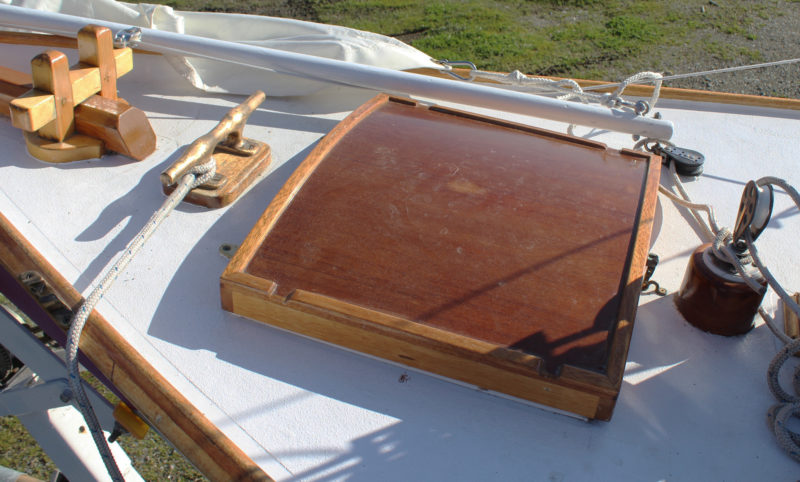
The forward hatch provides access to the storage space in the bow. The block to the right, held upright by a spring, is for the single sheet that controls the jib boom.
M y PT Cruiser has enough power to pull our Weekender. The boat has a somewhat deep keel for a flat-bottomed boat, so bunks are required under chines to support the hull. At the ramp, it’s easiest to float the boat off the trailer; at shallow ramps it can be a bit of a struggle sliding it off, in part because the two batteries I use for the trolling-motor auxiliary power add significantly to the Weekender’s weight. However, the boat can be winched up onto a trailer that’s not fully submerged. It takes as little as 30 minutes after arrival at the ramp to get the rigging in place and have it in the water; the most time-consuming part of launching and loading the boat is almost always the attention it attracts from people watching. When people gather around, the time at the ramp stretches out to a bit more than an hour.
The mast tabernacle is created with two strap hinges—one aft to act as the pivot, and one forward with a loose pin to lock the mast upright—and it works well. The two pairs of shrouds have turnbuckles that are adjusted each time the mast is raised; they remain connected, and only the forestay is removed for lowering the mast.
The 5’ bowsprit is fixed and anchors the forestay at its tip and the jib’s 60″ clubfoot at its middle. The club foot pivots about halfway out on the sprit, and the jib clears the mast when tacking and requires only a single sheet. I have added a downhaul to the jib so that I can both raise and lower the jib going no farther forward than the companionway. I also led the main’s throat and peak halyards to cockpit so I didn’t have to go forward to the mast to drop the sails.
To help keep the mainsail from overwhelming the cockpit when it’s lowered, I added lazyjacks. The plans specify eyebolts and a bit of pipe and metal strapping to make the gooseneck; I instead made an aluminum gooseneck with an extension that allows me to pivot the boom fully vertical and scandalize the mainsail. When coming into harbor, it’s a quick way to douse the mainsail and clear the cockpit for docking. This has proven most helpful especially when sailing alone. I also fabricated an aluminum masthead fitting to help with the rigging and give me a base for an anchor light and a wind-sock vane.
The rudder is in a rudder box that is an integral part of the tiller arm that is connected by lines and pulleys to facilitate a wheel. The rudder must be pivoted and locked up for transport. The wheel keeps the cockpit free of a long tiller that would most certainly use up the limited space. I find it quite handy.
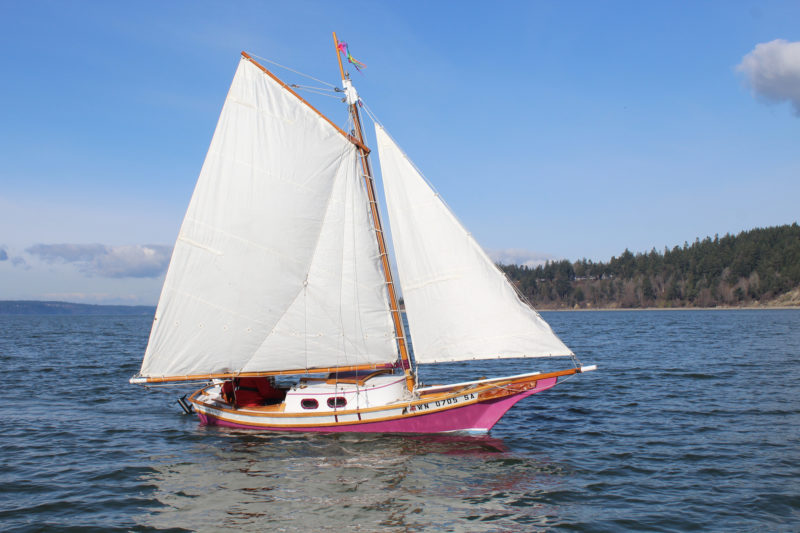
The Weekender carries a total of 120 sq ft of sail. The jib, with its boom and single sheet, is self tending, so tacking is uncomplicated.
U nder sail, the Weekender is like a sports car and very snappy in response on most points of sail. It can sail remarkably close to the wind for a gaff rig, and the self-tending jib makes tacking a snap. Its club foot is an excellent touch to the rigging, making singlehanding very simple. The Weekender can ghost along with hardly any discernible wind, although in light air it can be a bit hard to tack if the boat doesn’t have quite enough way on; the long keel requires some momentum to overcome its resistance to sweeping sideways when tacking. I have found that moving my weight to the downwind side forces the boat to heel, and it will gain speed and increase its ability to turn.
The Weekender is a pretty stable little boat, and ours is made a bit more so by the weight of the batteries for the trolling motor. It is stable when one is standing on the foredeck; however, it is a small boat, so if you step off-center it will move accordingly. But I have never felt that it was going to come out from under me.
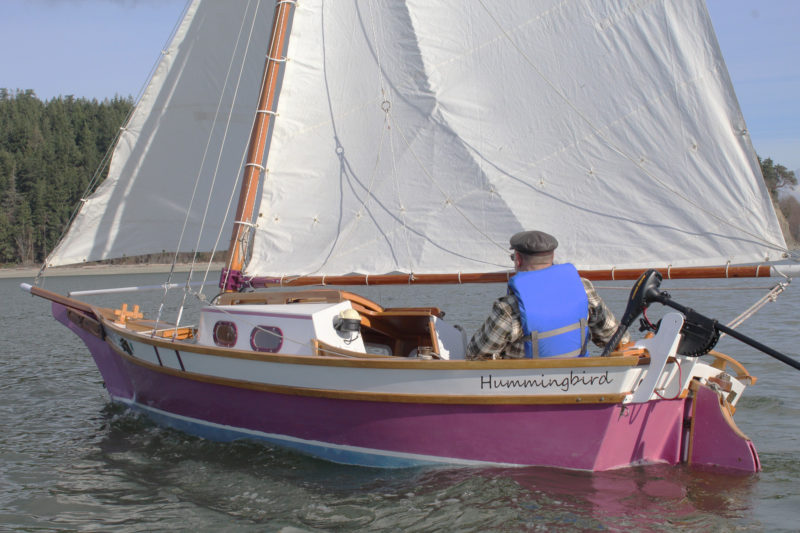
The Weekender was initially designed with a centerboard, but the full keel provided good performance to windward and the board and trunk were eliminated from the design, freeing up cabin space.
The hull can take waves better than one might guess for being so close to the water. The flat bottom can slap a bit depending on the angle of approach to the waves, but that same flat bottom can also surf down waves quite well, getting some help from the broach-countering directional stability of the full-length keel. I have found the cockpit to be generally dry with only occasional spray from hitting a larger wave. I prefer fair-weather sailing with our boat. When running dead downwind, wing-on-wing, the boat performs well; it’s a comfortable point of sail for the crew, with the hull sitting pretty much bolt upright.
For auxiliary power, we have a 55-lb-thrust electric trolling motor. While the plans call for a mount made of a 2″ x 10″ chunk of wood through-bolted to the transom, I designed and welded an aluminum bracket. The motor pushes the boat at just the right speed for harbor maneuvers, and provides an occasional boost to make a tack in light air. I have the two batteries on separate switches, but they can be combined for back-up power. I have run out of power only when I forgot to charge one of the batteries.
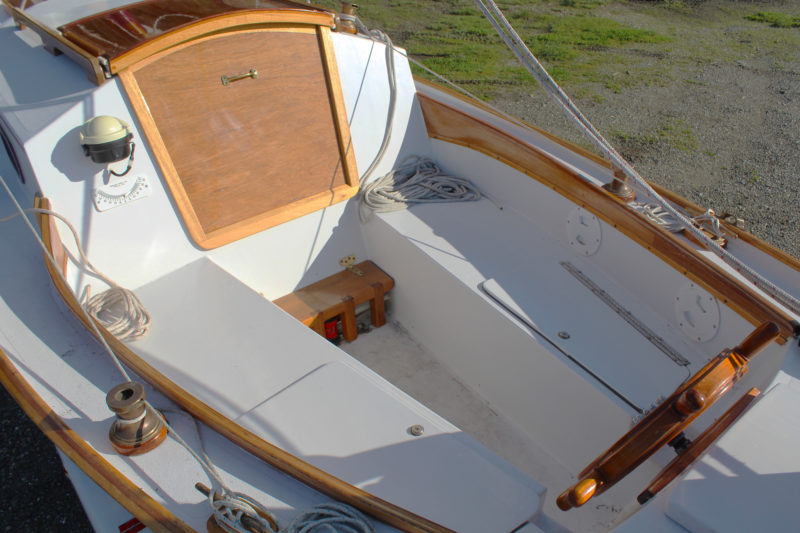
The cockpit benches include dry storage compartment aft and extensions of the cabin space forward.
The cockpit is not large, but it has enough room for the me and my wife to be comfortable, even when we’re sailing with our granddaughter and our small dog. The cockpit footwell is not self-draining and we have been caught several times in squalls that filled half of the cockpit, so I added a bilge pump under the hinged step at the forward end of the cockpit. The cockpit seats have hatches, and aft sections serve as storage. The curved coaming, shaped from a stack of 4/4 stock, makes a comfortable backrest and keeps water out when the toerail is in the water under sail. I cold-molded my coaming out of 1/8″ x 2″ sapele.
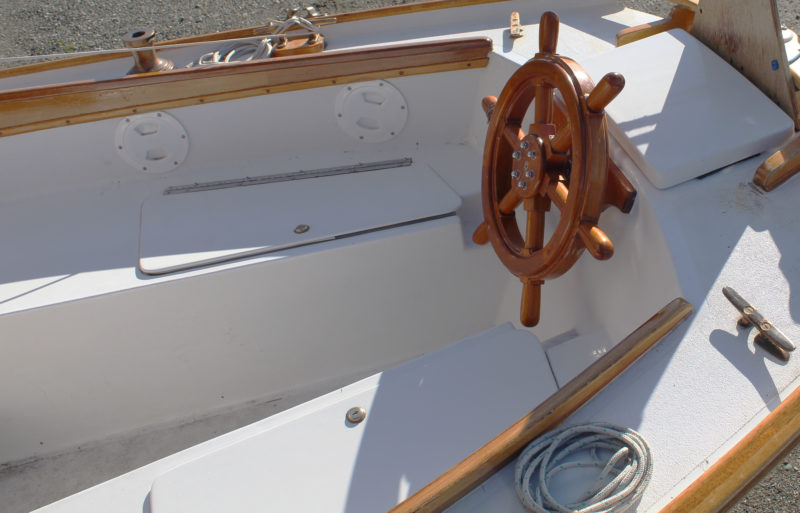
The wheel is more than an affectation. It doesn’t crowd the cockpit as a tiller would.
I added running lights to our Weekender as well as a small LED to illuminate the cockpit for the times when we are out later than expected or after dark at anchor. My wife and I have slept aboard comfortably on several occasions. We rig a boom tent for privacy and rain protection so we can keep the companionway open through a warm night; to clear the berths, we move most of the gear that usually resides in the cabin into the cockpit. The bottom serves as the berth and is flat, save for one transverse butt block, but with foam mattresses it’s not noticeable. The space works best sleeping with heads forward and our feet aft to take advantage of the space under the cockpit benches. Shelves with rails on their sides are a nice feature and are in fact part of the rigid framing.
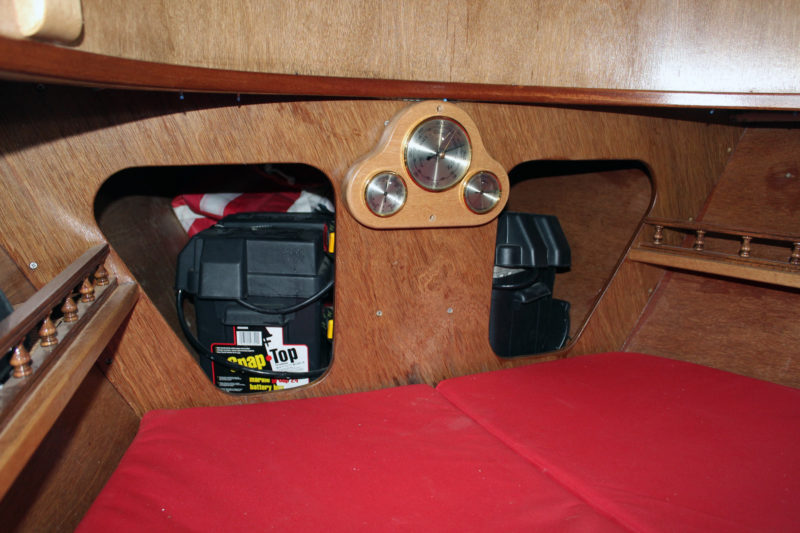
The bulkhead at the forward end of the cabin allows access to the storage compartment in the bow. Rails on the shelves port and starboard keep gear in place while under sail.
T he designed cabin has sitting headroom if you are of average height—I made our cabin a couple of inches higher than the design, for even more sitting headroom. There is no cabin footwell, so sitting is with legs outstretched on the bottom. There is access through the forward bulkhead to storage space under the foredeck, but it is easiest to use the foredeck hatch for larger items. The storage bin/seat at the companionway has proven to be a great addition for holding safety equipment, and it has also been a good speaker box for our CD player.
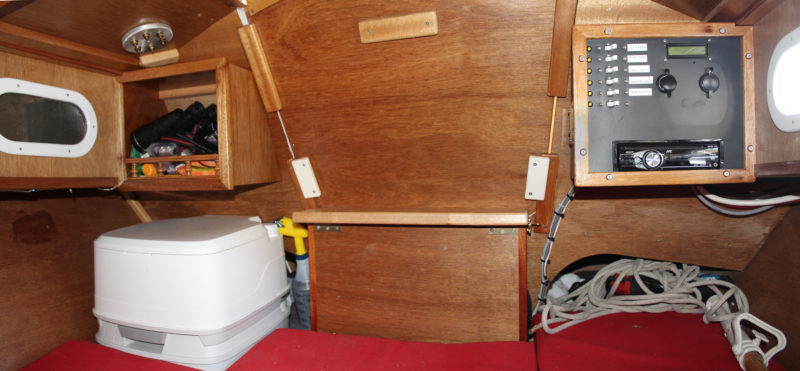
The aft end of the cabin provides a place to stow a portable toilet when it’s not in use. At right, one of the spaces under the cockpit benches is visible.
Ken Hauenstein lives in Burlington, Washington, just a few miles from Puget Sound, and is a general contractor who does all manner of work including interior boat remodels. He dreamed of working with boats from an early age and had his first real exposure working in a boat factory building interiors for cabin cruisers. He later worked in various shipyards and ran his own cabinet shop. His last shipyard job ended in 2017 as he made plans to retire. He started HUMMINGBIRD while working there. Since then he has built two dinghies, one wood and one aluminum. He is currently building a large aluminum ketch. He hasn’t set a launch date, and won’t because he finds the work therapeutic and likes to give the details all the attention they deserve.

Weekender Particulars
LOA/19′ 6″ LOD/16′ Beam/6′ Draft/3′ (1′’ with the rudder up) Hull weight/550 lbs Sail area/120 sq ft Crew capacity/Daysailing, up to four; Overnight, two cozily, one easily Auxiliary Power/up to 5 hp outboard or 45-lb thrust electric
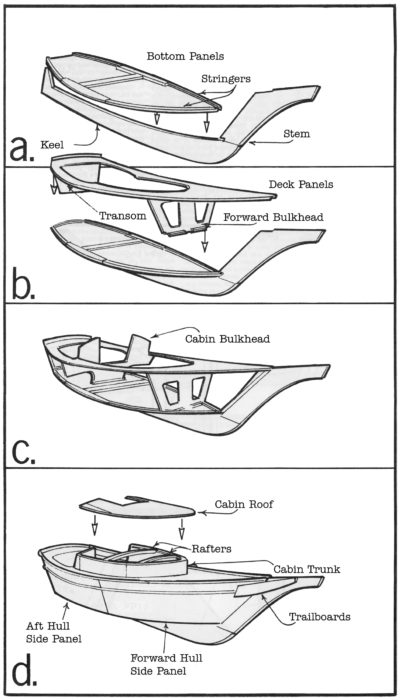
Plans ($45) and DVDs ($57) for the Weekender are available from Stevenson Projects .
Is there a boat you’d like to know more about? Have you built one that you think other Small Boats Magazine readers would enjoy? Please email us!
Share this article
Join The Conversation
We welcome your comments about this article. If you’d like to include a photo or a video with your comment, please email the file or link.
Comments (45)
Is there really enough headroom to use the porta-potti in the cabin?
The headroom in the cabin is limited to sitting, so the porta-potti is just stored there. I took the photographs for the review and I had only enough headroom for sitting on the floor cushions.
The cushions in the cabin have a removable section to move the porta-potti into the companionway should the need be dire. We have never used it since we put it in there however.
First, I would congratulate you for the amazing job you have done. I appreciate it as I’m currently building a Weekender for some time. The hull is quite finished now and the next step is the rig. I would be very interested in getting some pictures of the gooseneck and masthead that are looking very practical and better looking than the instructions suggested. J-Guy
I love my Weekender! It is indeed fun, stable and dry. Hoping this season to get a better video than this one from my iPhone.
J-Guy, Here are photos of the gooseneck and masthead fittings.
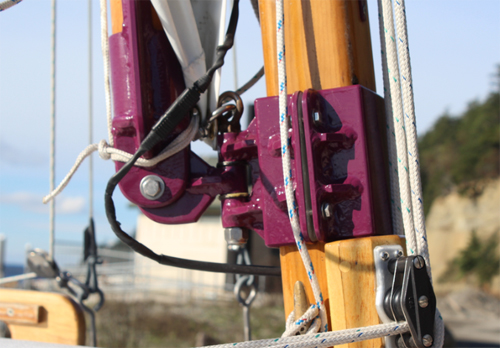
Who fabricated that for you?
Mark, I fabricated those myself. I was project manager in a shipyard while building HUMMINGBIRD and most of the parts I needed for them came out of the scrap bin. I fit and weld aluminum and steel.
When trailing: a) Does one unship the bowsprit so as not to need a trailer with a long front tongue? b) Do the spars stow within the length of the deck or overhang? Thanks in advance
I enjoyed the Weekender article, especially because I have built one of these boats. I hope this photo of my boat on the trailer will help answer Simon’s question. Notice I bolted on a short 2 x 10 forward on the trailer to carry the outboard motor, which is easily carried to the transom prior to launch. This way, potholes on the highway don’t bother me so much. The boat sets up quickly for sailing.The trailer is a bit large for the boat. The wider and lower bass-boat-size trailer gives a better towing experience and it all still fits in my garage.
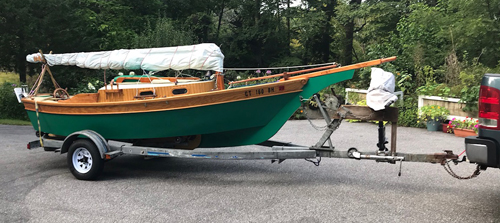
I have built and sailed a Weekender. I sailed it for four years. I have 30 years of sailing experience, and can tell you this design has some very serious flaws, mostly around safety, that I realized as I sailed it. First, it’s not self righting. At all. If you put it over, you are done. It will not pop back up, and becomes almost impossible to right again without help. And even if you get it back up, it cannot be bailed easily. And this assumes having as much flotation installed as you can! Without flotation, it might very well go under. It has no low ballast, which is a problem in many ways. Also, it has a very difficult time coming about. Very, very difficult time. It has to do with the sail plan, the hull shape, and the full length keel. I modified the keel quite a bit after the first year, adding to the center, and reducing it from the front 1/2, and that helped, but it still had a hard time coming about. This boat should only be sailed in very protected waters in 12 knots or less wind. it is easy to build, easy to trailer, and easy to beach, and looks very salty, but it has very poor sailing characteristics. Go to WoodenBoat’s forums and search for the Weekender. I wished I had before I built it!
I’ve made five Weekenders, two Vacationers, and two Skipjacks, and all have very similar hull forms. We have sailed them in a broad range of conditions and locations. They tack fine, they point better than they probably should, and they just work. I’ve never capsized any of them, although I have felt them being overpowered at times and adjusted accordingly by easing off, reefing, or heading back in. There are all sorts of responses to strong wind, depending on the boat and the days.
I’m sorry that John built one of our Weekenders without really understanding what the boat is and what it is not. Like many pocket cruisers, the Weekender is not a ballasted, self-righting boat. Self-righting isn’t a standard that many sailing dinghy, pod-type boats, open sailing skiffs, dories, or other traditional boats meet.
I just fielded a query from a customer a few days ago about whether to add ballast or not to a Skipjack, our 14’ open-cockpit gaff sloop. He had wanted to add 300 lbs of ballast to the keel of a 240-lb boat. The boat’s structure is not designed for this load, and the addition of ballast that close to the hull bottom and not extended away from it on a keel just wouldn’t be that helpful and wouldn’t make the boat self-righting. If someone doesn’t know how to sail an open dinghy, it’s probably not for them.
I’m sorry John had trouble sailing his Weekender, but we think the design sails well, given the limitations of a low-aspect-ratio gaff rig and a modified dory-type hull form. Over the decades, we have had a far more positive letters, emails, and phone calls about these boats than negative. Even the review here reflects this. We are sensitive to the fact that there are people who don’t have a feel for sailing these types of boats, or perhaps haven’t the range or depth of experience to draw from, and might well be frustrated that tacking a Weekender is not like tacking like a Capri 14 or some similar easy-to-sail machine with a centerboard. We have a section in the plans to help with sailing and tacking, and a good amount of discussion in the video as well.
I am truly sorry to hear, and entirely sympathetic with the unhappiness of having spent a lot of time building a boat only to be disappointed by it, but I don’t think that necessarily indicates a failing of the boat design. The Weekender, like the Vacationer and Skipjack, does tack fine, and it is an unballasted boat that is not self-righting. That’s the nature of the beast, and I’m sorry if it didn’t meet the expectations of a different boat.
I don’t think it’s possible to come up with a perfect design which will please and be all things to everyone. We surely don’t want to even hint that our little Weekender is anything like that. It is what it is: a cute, easy-to-build little sailboat with a classic-boat feel.
Mike Stevenson Stevenson Projects
I’ve had one I built for 19 years. I have had a lot of fun with my little boat, and it’s still happily sailing every summer. I sail her pretty enthusiastically, and have not had any problems. My dinghy-sailing training from when I was a kid prepared me for sailing a small, unballasted boat, so I didn’t suffer from any of the misapprehensions some folk seem to when they expect this boat to behave like a large, ballasted, round-bottomed keelboat- even when they ought to know better considering they built it themselves. It’s a fun little dinghy and is just right for camping with the built-in shelter. It can be rowed with oars or propelled by a trolling motor. It’s great for poking around islands and beaches and campsites.
Hi, Could Keith Shergold help me with the placement of the oar lock location and what would be the best oar length for my Weekender sailboat? Where do you think the best spot for the midship cleat would be? I am also building the trailer for my Weekender, so if you know where the axle placement location is best (noted distance from the back of the cabin bulkhead at seat level). Note there is no other builder nearby to help get the spec. from, so I would appreciate any input. I am stuck at the plywood build finish stage, and need to know where to put the backing in so I can get doing the real scary stuff: fiberglassing. I do not have heat in my garage so I have to wait for a dry sunny day with no or light wind, for the right conditions. So one more question: How much epoxy did you need to ‘glass? This is important to know because I live at the Lake, West Cove, Alberta, Canada, and need to go over an hour to the nearest possible supplier. I do not know at this time who is still open.
I bought the plans 20 years ago and have been sailing fiberglass boats since. I bought the revised plans last month and have the means to follow through this time. MEYG will be sailing in 2021 or 2022 out of Fairport Harbor on Lake Erie. “Life is too short to sail an ugly boat.” ~Anonymous. I don’t plan to take her out in a gale, but I think she will be a great boat for a single handed-sailor.
As I have mentioned before, I’ll put in a plug for water ballast. I like the clear poly water “cubes”, with a handle, as they come in different sizes (1 gal. to 5 gal.) and can be shifted easily as needed. One main advantage is that, in case of a capsize, the ballast has neutral buoyancy, and won’t sink the boat. Of course, water ballast won’t provide the righting moment that lead or iron sash weights will, but this safety factor to me is a strong argument.
At the end of the day, just dump the water out. No need to wrestle heavy ballast around once you’re back on shore.
Let me clarify: I’m not saying you shouldn’t build it. But if you are looking for a boat that seats more than three (and three is tight), is a responsive sailor, and you know you might get caught out in winds over 15 mph from time to time, this is not the boat for you. I decided to build this boat because of the way it looked, and its ease of building, and the fact that you use off-the-shelf parts for most of it. I realized afterword that I wanted a better performing boat. I sold it and bought a Montgomery 15, which is a better fit for me. And I will restate, I have a lot of sailing experience, and have sailed many different sizes and types of boats. This was the first I built. It does have problems coming about from time to time. Not always, but in certain wind conditions. At first I thought it was me, then after sailing other boats and coming back, I realized this design has some tacking problems. Is it a deal breaker? No. I would fall off a bit and try again, and could usually get through the second time. Pros: Easy to build esp. for beginners Easy to launch and trailer with pulpit design Can be beached Looks very salty Cons: Not self-righting or self-bailing Not a performance sailor Keep in protected waters Sail in winds under 12 knots (15 mph) unless you are an experienced sailor and have experienced crew
Here’s the Woodenboat Forum link . Lots of discussion here, and other folks with more experience than me. Same conclusions. Many defenders and detractors. I’m just stating my experience, and wish no ill will. It is easy to build, it looks great, and if you are looking for a boat to get out on a Saturday afternoon in protected waters, this is a great choice. It’s sailing characteristics are okay to good.
Thanks, John!
I appreciate your honest assessments and comments. It’s nice to have balanced forums and genuine information for people to learn from.
Mike Stevenson Projects
John, We have had one occasion in which an odd wind shear hit us during a tack and we rolled far enough to scoop water with the cockpit coamings. My wife got pretty wet. I let go the main sheet and she righted immediately. I have found the two batteries in the fore-peak do add a bit to her righting ability.
Hi Ken, I saw your sailboat pictures. Your side deck and cabin top had round wooden spools. Being new to sailboat building for myself and having none in the area, I was wondering are they fixed turning posts, ratcheting posts, or winches? And what are their designed uses? Your boat looks really nice in the pictures. Just viewing them is enough to make me want to finish my Weekender. Thanks
Gerald, They are actually bronze winches I salvaged from a boat we cut up in the shipyard I used to work at. The side-deck winches I use rarely except to tie things off. The cabin top winch I use to raise the main. It adds a bit more purchase.
Sorry to hear John had such an unpleasant experience with his Weekender.
I built one over the course of 7 years, making only one change to the plans … two 10″ x 18″ lexan panels on either side of the keel just forward of the storage box in the cabin giving me a “glass bottom” sailboat ! Helps the fishing and scalloping a great deal as our area ( Old Homosassa, Fl. 65 miles North of Tampa on the Gulf Coast ) has very ” skinny water”. That is anywhere from 24″ to 48″ unless one is in the river channels or the Gulf. HEART SONG has proven to be a very good sailor even in 20+ knot wind and seas in the Gulf. As always, the performance of a boat is generally equal to the performance of the crew.
As for self righting and being hard to tack ….. first of all … DO NOT cleat off or sit on the mainsheet ! If you get the lee rail in the water let the main out ! As for tacking … you will need to build up some good headway, then put the helm hard over in one quick motion (don’t be timid here). If in light airs it helps to backwind the jib, easily done with a club-foot jib.
What really helps here is to have some multi-hull sailing experience as the Weekender sails more like a “Multi” than a “Mono.” As for not being self-righting and difficult to tack, well the same can be said for one of the most popular afternoon sailboats ever built with over a million sailing worldwide. A design that has introduced thousand to the wonderful world of sailing. It’s called a HOBIE CAT. Our WEEKENDERS are in good company indeed !
Oh man, pictures please!
My wife and I had one of these in 1986 and sailed it on many lakes in Alaska. It was surprising how well it sailed. We were on Lake Louise one time and it was really blowing, we were getting pushed to the other side of the lake and we were getting concerned. I could not get the boat to come about, I finally insisted my wife raise the job and voila we came about and back to the dock. On another trip to Harding Lake we ended up racing a pretty modern ‘glass boat, I had the rail down in the water and water 1/2 way up the on the portholes, we ended up passing the other boat and we were hooked.
Great work! I just finished mine, have had a chance to sail it twice and am lovin’ it. I miss the build though – really enjoyed the process.
I was so excited to find a recent AND positive review on S.P. boats. My Pocket Cruiser is almost done and I am very happy with it. I made a few modifications, but overall it is great. Once I understood the type of boat it is and its positive attributes, it was perfect for my purposes. I am glad to see so many happy reviews. I’ve been planning to put an 86-lb trolling motor on it; I was so excited that a 55 -pounder does the trick.
Hello, Dennis,
I look forward to seeing your P.C. when you get it launched! I have a soft spot for that boat, as I did most of the design work on that one. It has a very different feel from the dory-type hulls: The beamier cat-boat-inspired hull is really mellow and relaxing! Peter and I were once sailing the prototype in shallow water and didn’t realize we’d caught one of the lee-boards in the mud! We were happily talking away, just enjoying the gentle slap of the water and the light breeze, and then one of us said “Hey! I don’t think we’re moving anymore!” We laughed and pulled the board up and jibed around out of the shoal, but it really was a funny, mellow moment! I hope you have great fun with yours! Mike Stevenson Projects
Are those the battery boxes I see in the forepeak? I suppose it would make sense to try to balance out the weight of two adults in the cockpit.
I know in our Weekenders, we put the batteries up forward. The boat likes a bit of weight up forward to balance things, as you noted. I hate the longer wire runs, but larger gauge wires and 24v motors help minimize the losses. Mike Stevenson Projects
Yes, those are the battery boxes. My thinking, in addition to what has already been mentioned, was that the extra weight at the base of the mast would help work against the leverage in those moments when you may have held the main sheet a little too long and to tight. As I mentioned earlier, it has proven to pull her back in tight circumstances.
I recognize a lot of the names posting, and give you my support. I am building a Vacationer, a few hours a day, and am within a few weeks of painting the hull. The amount of time it takes to build depends on the level of finish on the boat. I am looking forward to being able to sail mine.
I’ve been sailing my Weekender for ten years now and have made many modifications to it. I wouldn’t change the basic boat at all now that I have a fairly good idea about how to sail it. I thought about ballast, but no way. I have done a capsize test with my Weekender and can tell you that mine pops right up with a little push on the keel. I’ve got a ton of floatation in mine and she floated pretty high when I took her over. I have also found that she will sail pretty well on her side if I don’t get nervous.
I crossed the Straits of Mackinac in twenty knots of breeze with no drama at all. I typically sail in winds in the high teens gusting well over 20 with the only downside being my old hands get tired. After ten years of learning to sail, she has never gone over on me and unless I have a stroke at the tiller I doubt that she ever will.
All around, best boat I can imagine.
Al, I can’t tell you how much my father would have loved to read your note. He was always very personally affected by letters and emails and photos our builders sent in, which makes sense: A big part of why he designed things was to create fun for people. The original books he wrote about wooden toys came about because he just wanted to make some toys for me. That started a legacy of projects which just keeps going, and I’m very proud and thankful to be a part of it and to keep it rolling along!
I love your adventurous sailing nature! Thank you so much for sharing your fun and spirit with us all!
This is very encouraging. Here in Brazil I met a guy with a Weekender, he said it was one of the best small boats he had ever owned
Mike, DUCKIE is my first boat build and even after building a number of wooden boats, she is still my ideal. What I mean about best all around boat is that she is by far the easiest boat to live with for this old man. I can manhandle her on her trailer, pull her with a Toyota Corolla, and handle all the wind I care to go out in. Set up and take down are the easiest that I have experienced, except for all the attention she gets at the ramp. Well, she did win her class at the Port Aransas show, so there’s that. She takes off like a scalded cat after a tack, which really turns my crank. She is way faster than most think she should be. On occasion, I have seriously perturbed skippers on bigger, supposedly faster boats by passing them and then waiting for them, good times. Describing her as a dirt bike on water is pretty apt. Her light-air ability is the best in my fleet. I could go on all day. Bottom line, learn how to sail a gaffer and take advantage of a sharp chine, and most will understand what I’m saying.
Al, I hear ya!! (and not just creator-bias: I have felt that kick in the pants when one tacks and Off We GO!)
All the best, and stay safe up thataway!
Very much enjoyed the article and all the discussions. She is a handsome little boat that I am sure is quite pleasurable to sail. I have a gaff-rigged Eastport pinky ketch and a Sedgwick Sailing peapod that I designed, based on the Washington County peapod shown in Chapelle’s book. She is 13’ 6”, reduced from 15’ 3” with a long straight keel. She tracks like she is on rails and accelerated rapidly. In response to the various comments regarding tacking, I have found that technique is key. Head up very slowly and just before you come up into the wind, kick the tiller over and voila! Never fails. There is no doubt you can have as much fun with a small boat as a big one. I’ve had a blast sailing with the Small Reach Regatta in Maine for the past few years. The Weekender would be a welcome participant. I always look forward to the monthly submissions. Thanks for sharing.
Yep, that sounds like great fun! I’d love to join you one of these years, if the Fates allow. I very much agree with you (not surprisingly!): The lightweight gaffer is a Fun Machine, and one only has to look at the shots of the sandbaggers of decades past to see the seriously-exciting-looking fun they seem to have been having!
All the best from the West Coast — Stay safe, all!
Great project! I fell in love with it as soon as I saw it. We should thank Peter for his talent for combining simplicity, reasonable seaworthiness, and beauty. I’ve already finished building my boat and I’m looking forward to going on a serious voyage.
I built my Weekender back in 2000 and completed her around 2005. Loved the building process and sailing her. I was truly amazed at just how well she handles and tracts. The gaff sail rig truly maximizes the sail area. Looking forward to building another one some day. And Mike, when I do I’ll order another set of plans from you. Great boat!
Beautiful workmanship! I especially love the character of the shipyard-leftovers and self-fabricated parts! How well suited would you say the sailing is to the area? Any modifications you’d make if you got to start all over again (besides the very sensible lights, headroom, etc. that you mentioned in the article)? I’m looking to build my first boat soon and I think I’m on the same water as you, Ken. Would definitely look forward to building a Weekender!
As a avid carpenter I am surprised at the absence of glassing after so much work into such a beautiful craft – I am envisioning a whole lot of screw joints coming ” disjointed ” as they eventually become wet and damp – What would be the offset to elevating the cabin roof another foot? Even at 2021-22 prices would anyone want a stiffer (rot-resistant) stem when putting this sprite under the stress of beaching, trailering, or keeling in a 25-knot wind? And ad yuears to her life? Well worth the mahogany or joined oak that she deserves. Comments welcome, especially those that have plied this beaut 10 years or better.
I have sailed my Weekender for over ten years now and can vouch for the toughness of the boat in all regards. I once sailed her up the rough concrete landing at a marina under full sail in twenty knots with no damage at all. I had a plastic shoe on the keel, but it was only scratched a bit. There was an avid crowd of witnesses at the time, and they were shocked to see me laughing and shoving her back in the water. If the landing is crowded, I always beach the boat out of the way to wait my turn, and over the years, my boat is like new. My keel is made of ACX 3/4 inch plywood which has stayed straight and un-degraded.
I glassed the entire outside, but left the interior for paint. I painted the interior very carefully to ensure that it would stand up to a dunking. As long as water doesn’t stand around inside she is okay.
I also added two inches to the height of the cabin, and I don’t think I would add more because I don’t want to ruin the look of the boat. I have noticed that the designers once built a Weekender with a pop up, or removable top. Not the worst idea if sitting upright is important. If I am going to spend any time in the cabin, I simply pile all my junk against the forward bulkhead and recline against that. I have also learned the drawbacks of too much windage, which the cabin is the primary culprit therein. You will notice it.
I`ve read this article about the Weekender Sailboat now twice. This is a very good description about the Weekender and I can really agree in all Points. I built one and yes it’s a joy to sail. I also raise the cabin height double than the original. It’s much comfortable. There is one Thing where I’m not so happy. The foredeck is drawn flat and the water can not flow overboard. Unfortunately I recognized it too late. In that time I was not so experienced in boatbuilding. Another thing was hard to learn the imperial measurements.
I present my Building Story on the Stevenson website. I hope you can enjoy
So thank you for this nice article to read.
With Kind regards from Germany!
Michael Beckmann
Leave a Reply Cancel reply
Your email address will not be published. Required fields are marked *
Stay On Course
More From This Issue
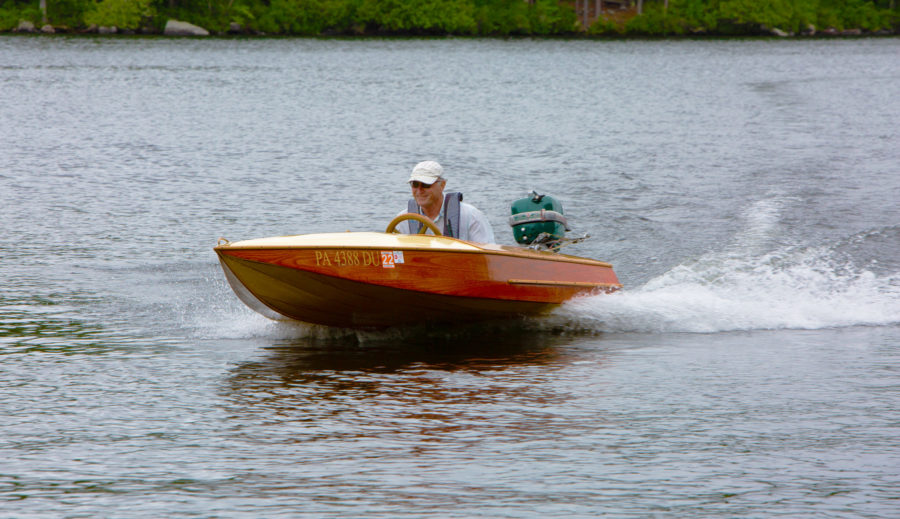
Midget Flyer
When I piloted the Midget, I found that at low speed its trim is close to level; the bow rides up slightly, but not in an unsightly manner. With a…
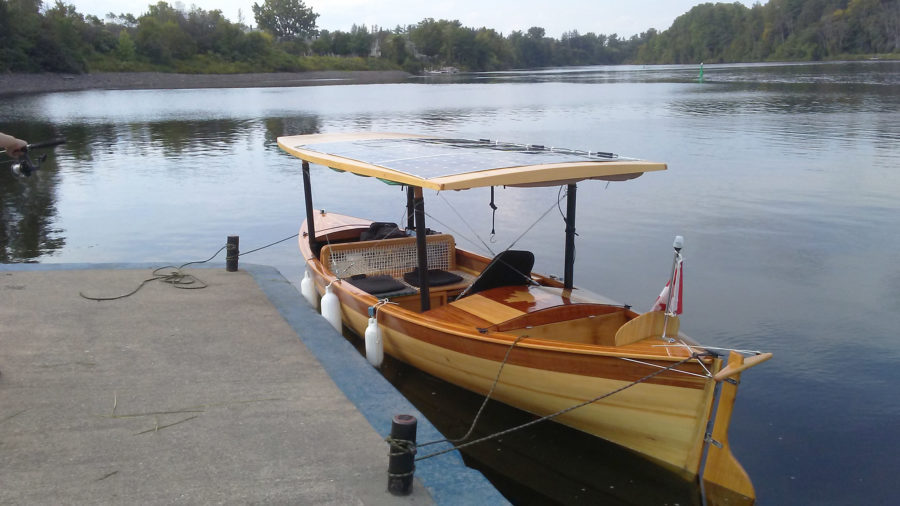
A Solar Solo
SOL CANADA had been performing fairly well, but about once an hour the motor would just stop. I could get it going again by putting the throttle neutral for a…
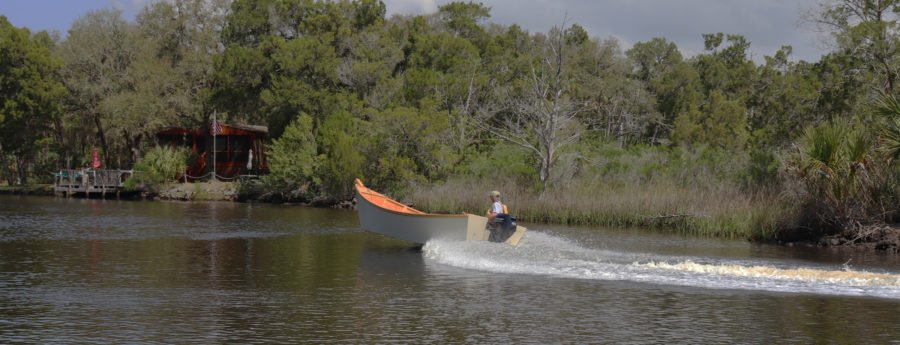
Carolinian Carolina Dory
I came across Spira International’s website on a random internet search. I was intrigued by some of the designs and happily surprised that the boats could be built using construction-grade…
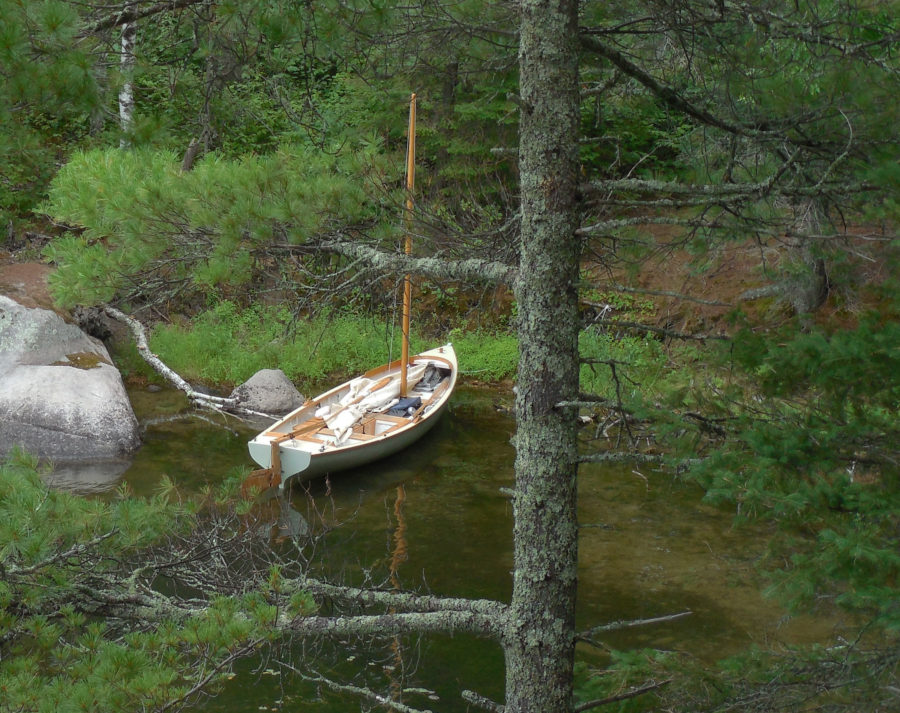
A Red-Lantern Journey
My plan was to head northeast across Sabaskong Bay and into Turtle Lake, a connecting bay with an entrance channel so narrow that its opposing shores merged into a single…
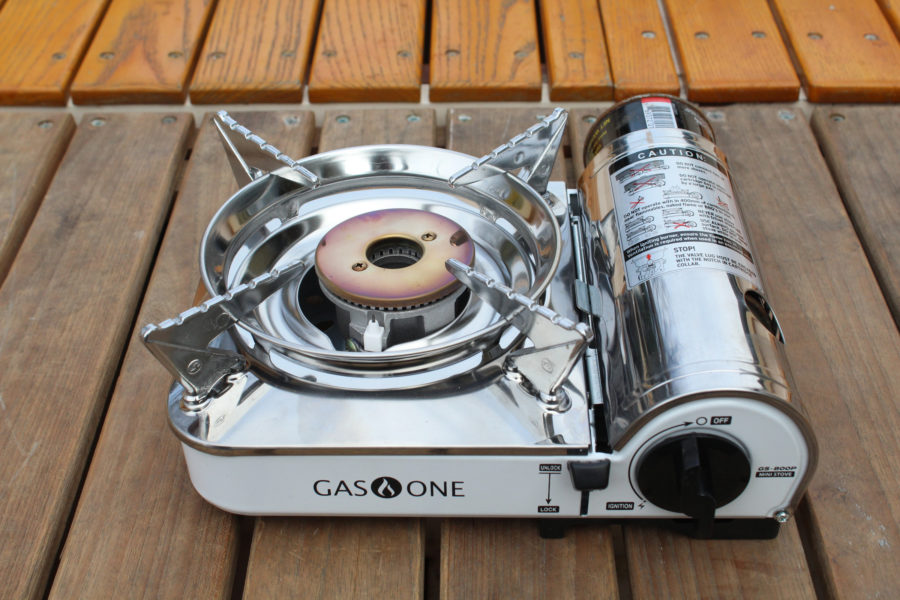
Product Reviews
GasOne’s Mini
I did trials to see how the Mini compared to my familiar stoves. With the air temperature at 46 degrees Fahrenheit and the water from the tap at 52 degrees,…
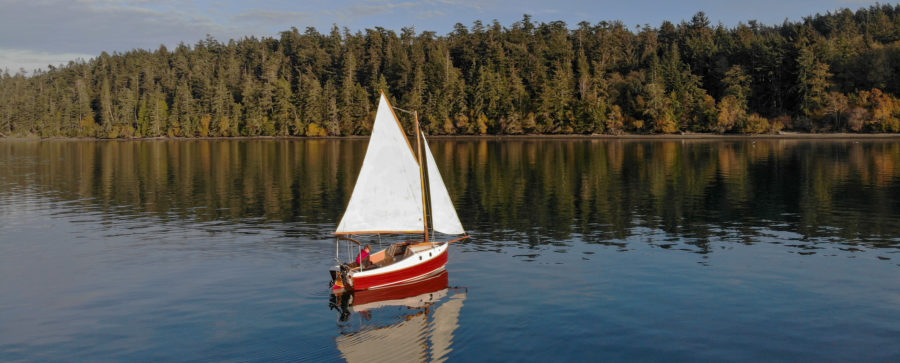
John Harris, the proprietor of and chief designer for Chesapeake Light Craft, designed the PocketShip as his personal boat. “I'd owned a production fiberglass pocket cruiser, which sailed well but…

Under sail, the Weekender is like a sports car and very snappy in response on most points of sail. It can sail remarkably close to the wind for a gaff…

A DIY Cagoule
I lost track of my original cagoule, so I recently re-created a pattern and sewed up two new cagoules. The first was a bit tight over my knees when I…
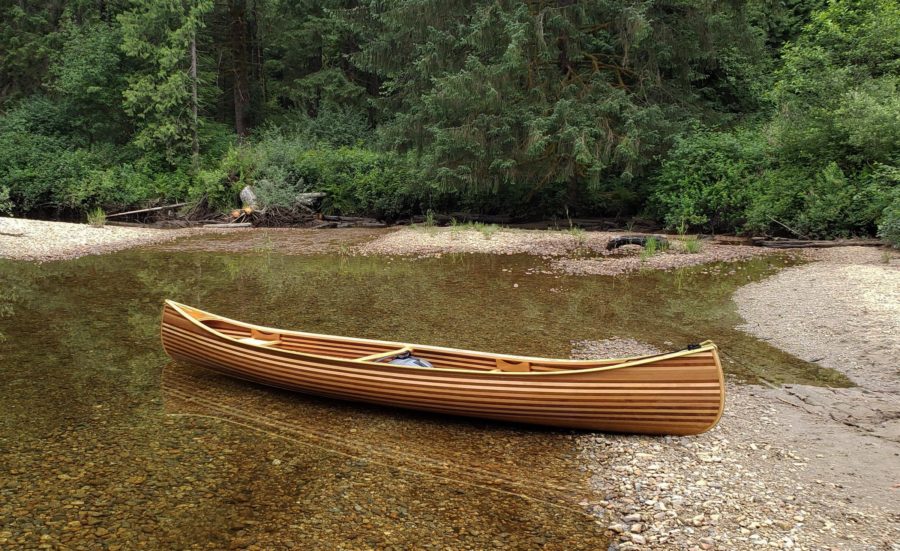
Reader Built Boats
The Yeung Canoe
That fall, Rebecca and Kimberly, now 14 and 12, began work on a Prospector Ranger 15 canoe kit from Bear Mountain Boats. Their father, Winston, helped with the project and…

A Gaff Sloop
Paul Gartside’s 16′ Gaff Sloop, his Design No. 218, has its roots in SJOGIN, a 22′ traditional double-ended Scandinavian workboat built in the late ’50s. Paul designed a modified version…
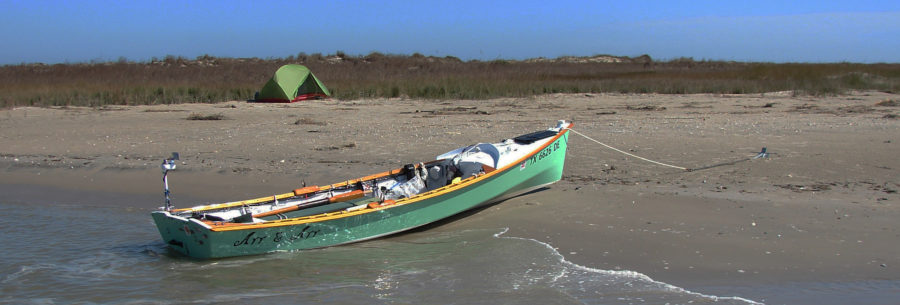
Sunday Pass
For a weekend, the waterways were surprisingly quiet, without a single fisherman in sight, and Port O’Connor resembled a ghost town, inhabited by only birds. Gulls hovered in the breeze;…
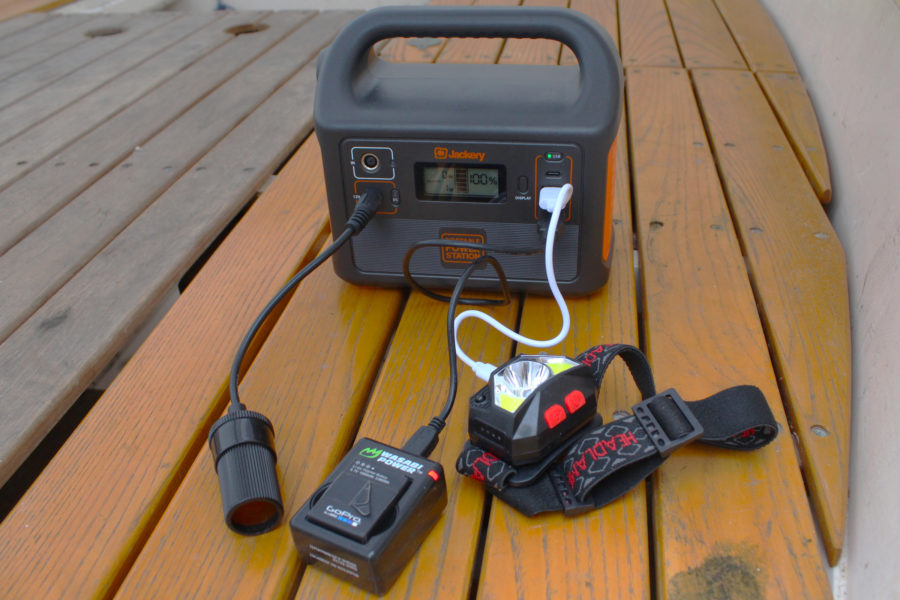
Jackery Explorer 160
The Explorer 160 delivers that capacity in a 7.5″ x 4.75″ x 6.9″ package that weighs just under 4 lbs. The face of the unit has two ports for 12-volt power,…

FALCONE de PALÙ
Detlef Arthur grew up in southern Austria and while he did a lot of boating on lakes and rivers, Italy’s coast was not far away and he occasionally traveled with…
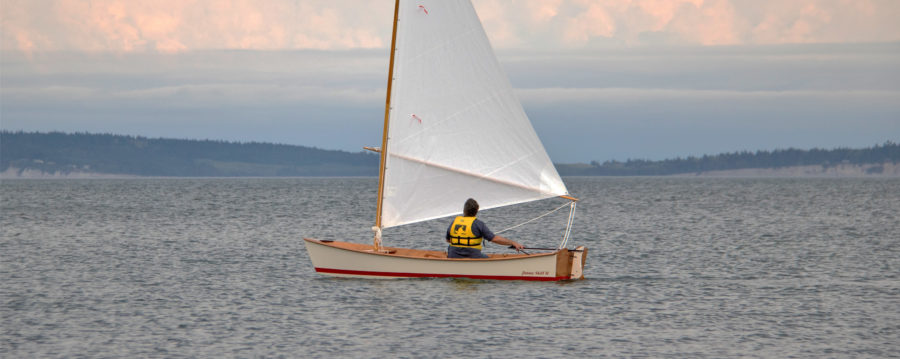
Jimmy Skiff II
Eight plywood panels make up the kit’s hull; its bottom and sides are all composed of two pieces joined together with puzzle joints and the transom is built up of…
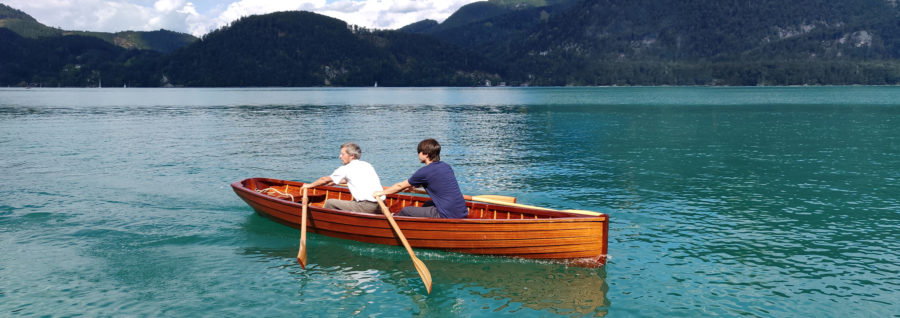
Wolfgangsee skiff
Lukas Schwimann’s home is in the village of St. Gilgen, Austria, at the top end of Lake Wolfgang—Wolfgangsee in German. A friend who lives near him owns a 16′5″ rowing…
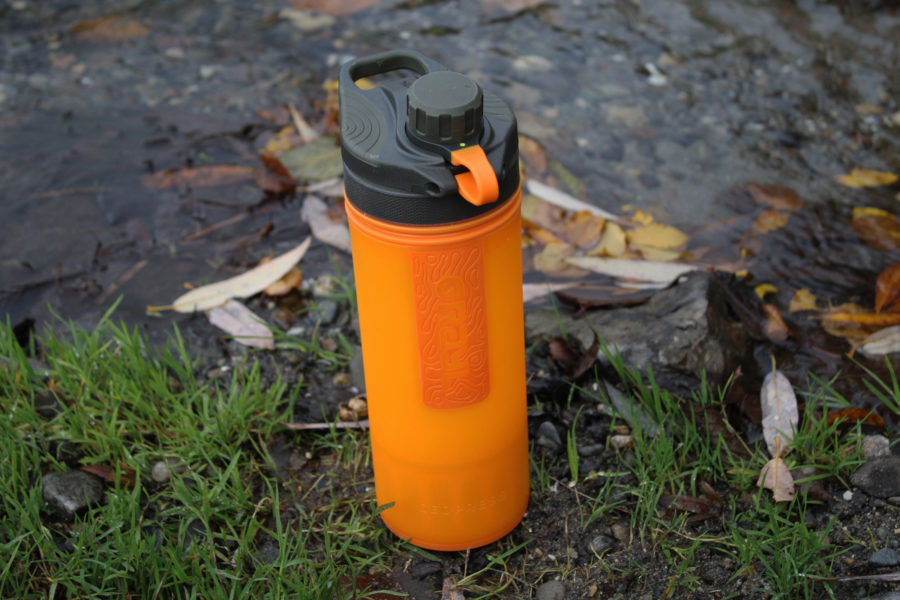
Grayl’s Geopress Water-Treatment System
The filter uses a combination of ceramic fibers for particulate removal, positively charged ions to bind pathogens, and activated carbon to adsorb chemicals and impurities. The manufacturer claims that the…
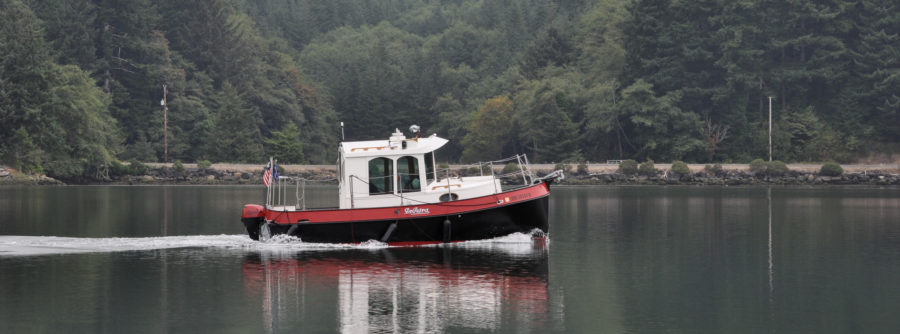
Glen-L Bo-Jest
The three pages of plans were clear, but required extra study for me as this was my first plans-built boat. (I had previously built an Adirondack guideboat from a partial…
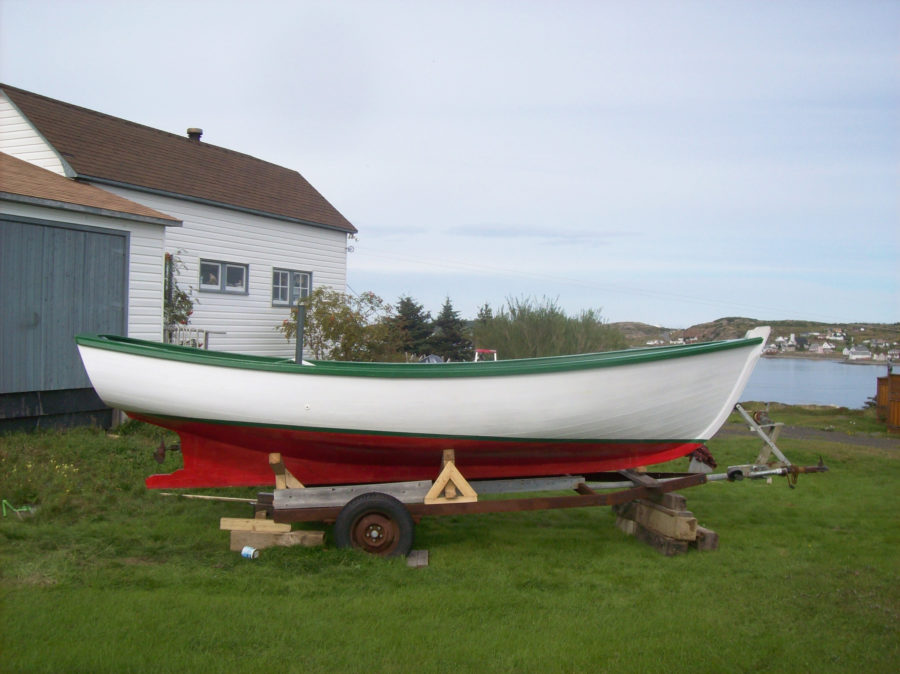
Alf’s Trap Skiff
As a boy, he would surreptitiously take the axe from his father’s shop and chop a boat out of a scrap of wood. There were a number of boatbuilders near…
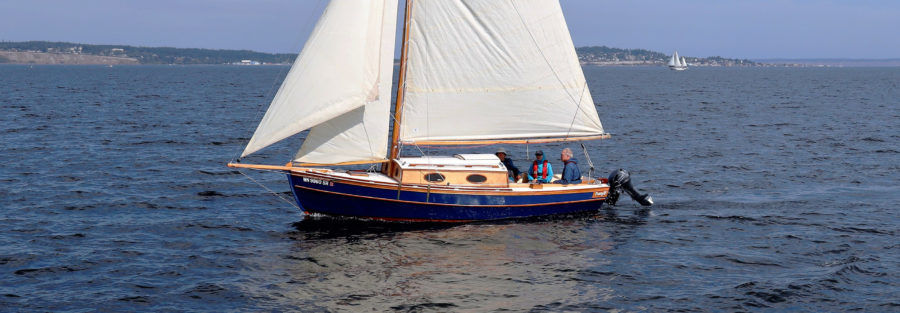
A cruising sailboat in the 20′ to 22′ range resides at the high end of the spectrum that most amateur boatbuilders can realistically aspire to. Go bigger and you need…
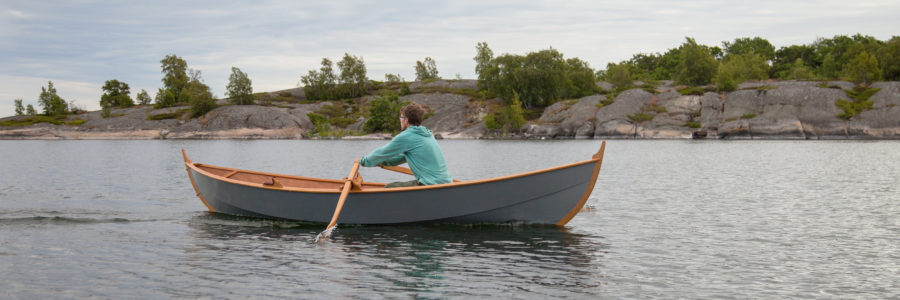
The original faerings were built by hand and eye, and had slowly evolved during hundreds of years to meet the local conditions and particular purposes. Iain carefully studied every design…

Super Sailfish
In 1946, Alex Bryan and Cortlandt Heyniger had combined bits of their first names to create Alcort, Inc., and the first sailboat that they designed, in 1947, was the 11’7”…
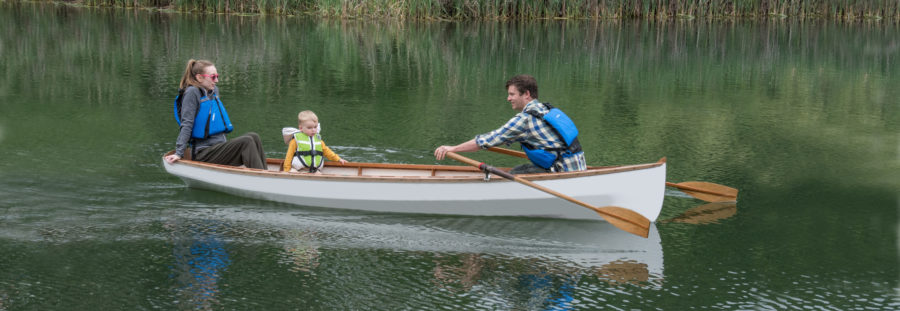
Whitehall Tender
Shenandoah Whitehall
The construction went quickly. Every major project I’ve ever begun has a hidden “gumption trap”—a difficult and unrewarding challenge that sucks the will to persist right out of me. This…
More Boat Profile
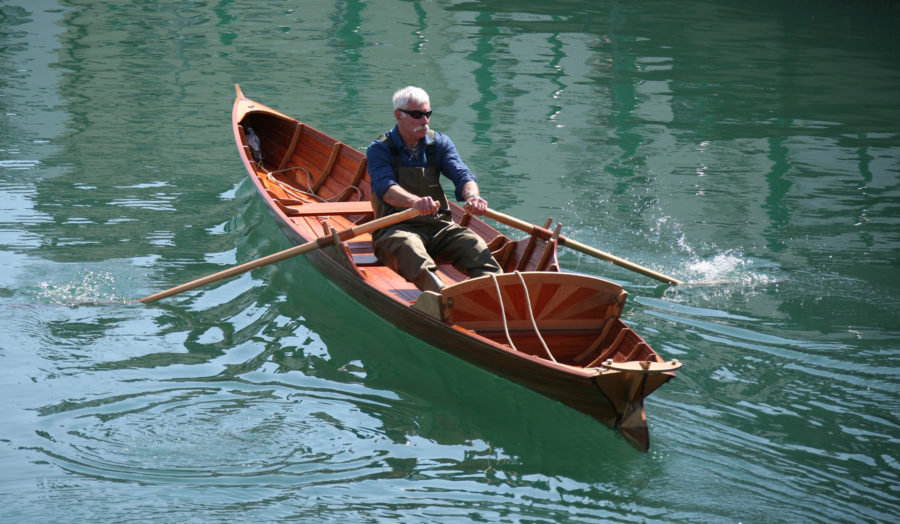
Within the pages of Eric McKee’s Working Boats of Great Britain there are drawings of a 24′ Thames skiff attributed to W.A.B. Hobbs* at Henley-on-Thames in the very early part…
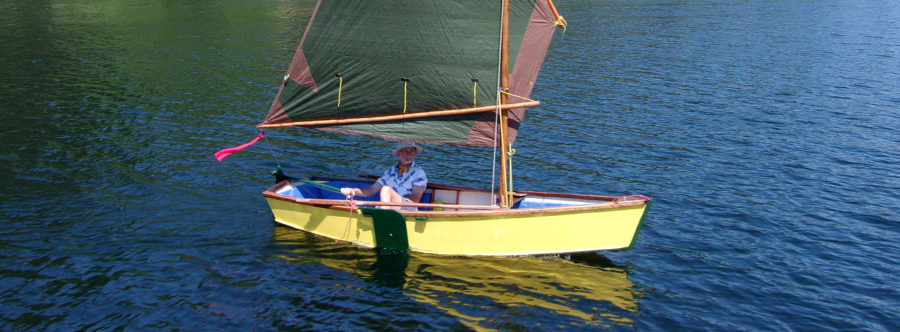
Summer Breeze
Designed to be the most boat from the least materials the Summer Breeze is a robust all-purpose skiff targeted primarily at pleasurable rowing and sailing in protected waters, but also…
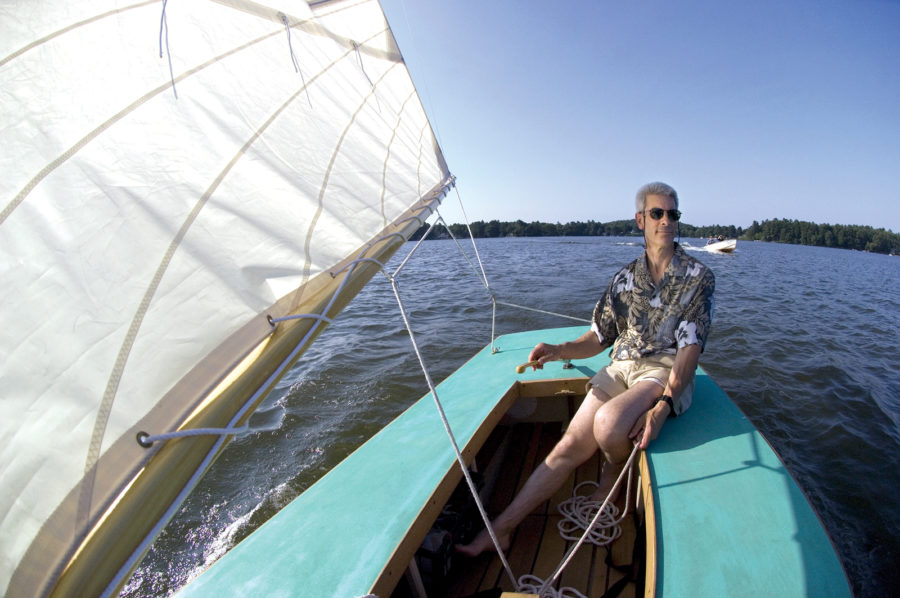
The Ipswich Bay 18
From the 2008 Small Boats Annual - The Ipswich Bay 18 is a decked sailing dory reminiscent of the small racing boats of the Massachusetts North Shore of the first…
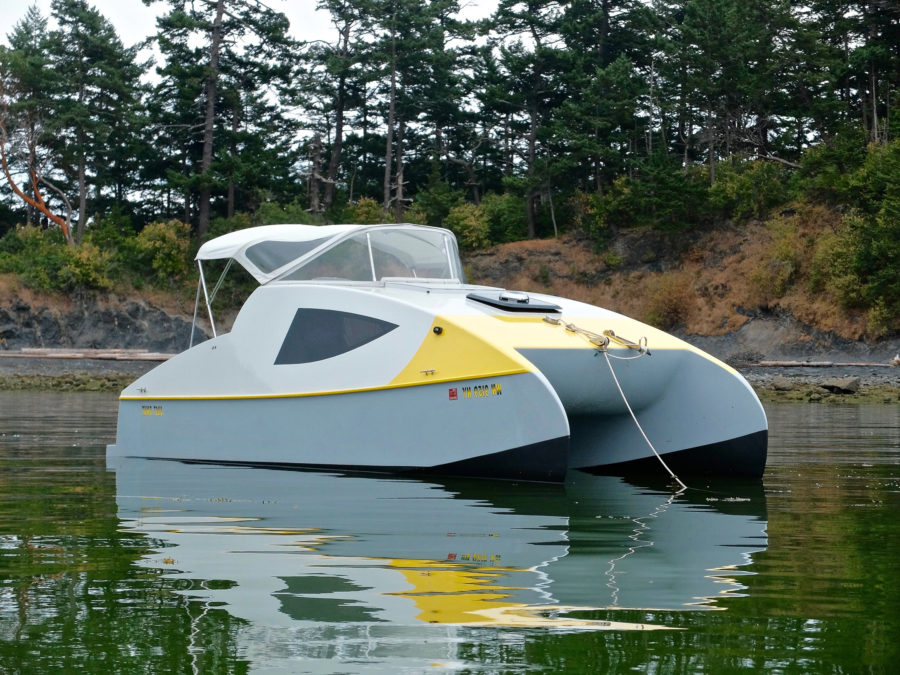
Eco 5 Power Cat
Was it time for another boat? In the 1980s, it was a 16′ sailing dinghy that awakened my wife Barbara and me to the beach-cruising pleasures of the San Juan…
Subscribe Today!
Become a subscriber today and you’ll recieve a new issue every month plus unlimited access to our full archive of backlogged issues.
Already a subscriber? Sign In
Subscribe For Full Access
Flipbooks are available to paid subscribers only. Subscribe now or log in for access.
Welcome to the Wonderful World of Weekenders!
The Weekender has been our most popular boat design for many years, and we understand why: It has a Classic Style, based loosely on the amazginly pretty Friendship Sloops of New England, and the Weekender is a perfect size for "simply messing about in boats"! It's small enough to be easy to handle, to build, and to store, yet it's still roomy enough to stay overnight in (or just take a nap on a nice afternoon in your driveway, as we've done more than a few times!)
Over Forty Years ago we first brought out this design amnd it has remained one of our most popular boats — And we quite agree with our builders: It's our favorite, too!
Read On to learn more about this Amazing Boat!
NOW AVAILABLE AS DIGITAL PLANS and VIDEO!!
For many years people have been asking us to bring out a digital version of the Weekender plans for download. Well, the Weekender plans have just been completely gone through (updated drawings, new Plans Addenda for improvements, and new additions to the text!) and we are now offering Immediate Digital Download of the plans!
AND...We Now Have the whole of the 3 1/2-hour Weekender Home Boatbuilding Course available as downloadable or streaming video!
Just as the plans needed to move to a more modern format, so too did the Weekender Boatbuilding Video. We shifted forward from VHS tapes to DVDs, and now on to online video files which you can stream or download to a tablet or laptop for use in the workshop!
Order the Weekender Plans, the Video Series, or BOTH below, and scroll down this page to learn LOTS more about the Weekender!
The Weekender in Small Boats Magazine!
Read the article they published about our weekender design.
Click Here to go to the Pocket Yacht Model Page.
Printed plans are available on a limited basis: Contact us for more information. (The DIGITAL ones are better!)
If you would prefer the video on DVD, rather than online video, please Click Here.
Click Here for more information.
Click Here to start exploring the photo galleries!
Copyright 2024 Stevenson Projects LLC

9 Best Trailerable Sailboats

Sailing is an excellent activity for the weekends, especially in remote mountain lakes or sheltered waterways. The United States is full of small isolated waterways, inland lakes, and rivers—which make the perfect environment for an adventure in a small sailboat .
Unfortunately, many people are put off by the idea of owning a sailboat due to the associated docking and maintenance fees. Weekend sailors often don’t want to pay for a long-term slip, and there’s no question that the added expense can be a pain.
Luckily, you don’t have to permanently dock a sailboat to enjoy this great pastime.
Instead of docking a large boat, you can purchase a small trailerable sailboat. A trailerable sailboat is a perfect option for part-time sailors and people with busy lives. Trailer sailors are some of the most popular boats in the country, and they’re not limited to light winds and calm seas. Many trailerable sailboats have made some impressive passages both offshore and coastal. In this article, we’ll go over some of the top new and used trailerable sailboats that you can purchase today.
Table of contents
Best Trailerable Sailboats
1) west wight potter 15.
{{boat-info="/boats/west-wight-potter-15"}}
The West Wight Potter 15 is perhaps one of the most capable 15-foot sailboats around. This neat little vessel is as seaworthy as it is easy to handle, and it’s a great choice for all kinds of cruising adventures.
The West Wight Potter 15 is a 15-foot sloop with an aluminum mast and tiller. This tiny boat also features a small cabin, which has ideal sleeping accommodations for a cruising couple. The cabin itself is spartan compared to its larger relatives, but it’s the perfect design for the minimalist cruiser.
This small sailboat is easily trailerable and can be stored in some garages with relative ease. The West Wight Potter 15 is ideal for inland and coastal waters and sets up (and takes down) fast with minimal fuss. Don’t let the small design fool you—this craft is surprisingly seaworthy.
The West Wight Potter 15 has an impressive cruising record, including a trip from England to Sweden in the brutal North Atlantic. The West Wight Potter 15 can be purchased new from International Marine, and thousands of craft are in circulation already.
2) West Wight Potter 19
{{boat-info="/boats/west-wight-potter-19"}}
We thought it fitting to include the Potter 15’s big brother, the West Wight Potter 19, on this list of the best trailerable sailboats . West Wight Potter boats are well known for their robust design and easy handling, and the Potter 19 is no exception.
The West Wight Potter 19 boasts the seaworthiness and ease-of-handling offered by its little brother, with the benefit of greater sailing comfort and cabin accommodations. This 19-foot sailboat is constructed of fiberglass. The hull contains a liberal amount of positive flotation, which makes the boat practically unsinkable.
The cabin features generous accommodations for a boat of its size, featuring space for a vee-berth, a small stove, a sink, and a portable head. Additionally, the West Wight Potter 19’s cabin can be wired for electricity from the factory, further increasing the level of comfort in this capable trailer sailor.
Like its smaller alternative, the West Wight Potter 19 has a history of some impressive cruises. An individual sailed this craft thousands of nautical miles from California to Hawaii —a single-handed voyage usually reserved for boats twice its size.
That’s not to say that the Potter 19 is a purpose-built long-haul sailboat. This design is ideal for larger lakes, rivers, and coastal cruising. However, the design has demonstrated toughness and seaworthiness rarely found in smaller boats.
The Potter 19, like the Potter 15, is a centerboard craft. This sailboat is available new from International Marine and offers a wide range of options packages and upgrades.
3) Newport 27
{{boat-info="/boats/capital-yachts-newport-27"}}
The Newport 27 is a massive step-up in size and amenities compared to the other boats on this list so far. This comfortable trailerable sailboat originated in 1971—at the height of the fiberglass boat boom. The Newport 27 measures 27-feet in length and feature a flush-deck design similar to the famous Cal 20.
This sailboat, despite its trailerable size and weight, features surprisingly good handling characteristics and generous accommodations. A full 6-feet of standing headroom is available in the cabin, making this boat exceedingly comfortable for longer journeys.
This sailboat is an excellent choice for the trailer sailing sailor who dreams of longer journeys but spends much of the time just hopping around local ports.
Despite its modest size and weight, the design of this small sailboat is proven. Many people sail them long distances and enjoy the quick handling characteristics of its design.
The Newport 27 is a true pocket cruiser, if not slightly larger than most. The Newport 27 isn’t produced anymore, but there is a healthy second-hand market for the boat.
4) Cape Dory 28
{{boat-info="/boats/cape-dory-28"}}
The Cape Dory 28 is a legendary Carl Alberg design known for its commodious living spaces and well-rounded performance both offshore and inland. This spacious little cruiser has the styling and capability of many larger boats, featuring traditional styling and generous amounts of varnished teak and brass. This cozy boat is a great choice for traditionalist sailors.
The Cape Dory 28 features a proven, simple, and robust rig, and it functions gracefully in a variety of conditions. While a 28’ sailboat is hardly considered trailerable by many, it can certainly be hauled-out and transported with relative ease. This is the kind of sailboat that’s just as happy in the boatyard or a permanent mooring.
The Cape Dory 28 offers attractive features for long-haul voyages, plus ease-of-handling and quickness that is necessary for tighter coastal waters. The Cape Dory 28 is ideal for salt-water cruising, though it’s a bit large for small lakes and narrow rivers.
This is certainly not a shoal-draft cruiser—with a draft of 4-feet, it's primarily at home in the water.
5) Islander 24
{{boat-info="/boats/islander-24"}}
The Islander 24 is a common fiberglass classic that makes an ideal trailer sailing setup. This 24-foot fiberglass boat features a robust design and ease-of-maintenance rarely found on boats with similar capabilities.
The design has been around for over 40 years, and it’s served weekender and cruising sailor alike. The Islander 24 is a well-rounded cruising vessel with a spacious cabin for two (or more). The cabin features a forward vee berth, space for a head, and tables for a sink, stove, or navigation.
The boat is single-handed with ease, and the rig is simple enough to be stowed without too much hassle. The Islander 24 is a relatively common trailer sailor, though many owners leave it in the water.
A vessel of this size is ideal for cruising coastal waters, though some sailors have attempted longer voyages in this vessel. The Islander 24 is available on the used market all over the country.
6) Contessa 26
{{boat-info="/boats/contessa-26"}}
The Contessa 26 is an excellent classic trailerable sailboat. Don’t let its modest size fool you—this cruising craft has a long-standing reputation for seaworthiness. The Contessa 26 is a fiberglass boat that debuted in 1965 and has since earned a bit of a cult following.
These rather innocuous looking crafts are as fun and capable as they are easy to handle. The boat features a spacious cabin, comfortable cockpit, and plenty of available cruising upgrades. The rig is well-built and resembles the rig of a much larger boat.
The Contessa 26 is an ideal pocket cruising setup for a moderately experienced sailor. The vessel has a narrow beam, which contributes to heeling. The boat is known to heel rather violently, but it stiffens up shortly after and becomes a joy to sail.
A boat like this knows its capabilities and is sure to impress anyone. The Contessa 26 is a safe, hardy, and comfortable cruising boat for minimalists, and one of the best tailorable sailboats in the mid to large-size category.
This boat is a little harder to come by than many other vessels on this list, as around 300 were built. However, if you’re lucky enough to locate one on the used market, it’s definitely worth considering. Contessa built a fine boat, and the Contessa 26 meets the standard with confidence.
7) Hunter 27
{{boat-info="/boats/hunter-27"}}
If you’ve made it this far down the list, you’re probably surprised that the Hunter 27 hasn’t come up yet. This famous little boat has quite a reputation and happens to be one of the most popular modern trailerable cruisers available.
The Hunter 27 isn’t a traditionalist’s dream, but it offers the modern amenities and capabilities you’d expect from Hunter. This capable little sailboat has the handling characteristics of a truly seaworthy boat and manages well in all kinds of conditions.
The Hunter 27 has a reputation for amazing durability, and the design is sound from keel to masthead. Now, let’s get into some of the features that make the Hunter 27 a very attractive option. The Hunter 27 is a purpose-built small cruising vessel, but the accommodations appear to be a shrunken version of a boat 10 feet longer.
Down below, the Hunter 27 features a full galley, head, a full standing shower, berths, and generous storage space. The Hunter 27 is a truly livable trailer sailor, featuring accommodations that make it suitable for extended cruising or even living aboard. The salon features over 6 feet of standing headroom, with plenty of seating and counter space throughout.
The rig is sturdy and easy to handle. And remember, the Hunter 27 is still a trailer sailor. The boat features a shoal draft of under 4-feet and a displacement of less than 8,000 pounds. The Hunter 27 is available used, and this boat is still produced and available brand-new by Marlow-Hunter.
{{boat-info="/boats/cal-20"}}
How could we forget the little Cal 20? We didn’t—and it’s certainly worth including the famous Trans-Pac underdog on this list. The Cal 20 is reminiscent of the glory days of fiberglass sailing in the 1960s and 1970s.
This flush-deck racer is a fantastic trailer cruiser for anyone wanting big-boat handling and speed in a compact package. The accommodations on this boat leave something to be desired, but many people find them cozy and acceptable.
The cabin features sitting headroom and a berth, along with small tables for a stove or sink. The Cal 20 has a history of impressive voyages and was a popular choice for daring sailors on long offshore journeys. However, the boat is designed to be quick, safe, and fun on inland passages and coastal cruises.
The Cal 20 is common on the used market and makes a great entry-level cabin sailboat. The Cal 20 features an enormous cockpit, making it ideal for a day on the bay with friends or family.
The boat is easy to handle, and upgrades abound. The Cal 20 is a great little sailboat with a fun history and a massive fan base. This stout little yacht makes an excellent weekender too, and the cabin makes overnighting comfortable.
9) Pacific Seacraft Flicka 20
{{boat-info="/boats/pacific-seacraft-flicka-20"}}
One of the most legendary small trailerable cruisers is the full-keel Pacific Seacraft Flicka 20. A limited number of these boats were produced by Pacific Seacraft during the 20th century, and they have a reputation for incredible seaworthiness and long-range voyaging.
These sailboats have the hull shape of boats twice their size, with a long, deep, full keel running the length of the hull. The boat can handle some serious offshore cruising and features the capabilities of other full-keel sailboats.
The Pacific Seacraft Flicka 20 is an amazing find on the used market, as owners tend to cling to them due to their incredible characteristics. There aren’t many trailerable offshore cruisers available, which is because it’s not easy to design a small boat with offshore capabilities.
However, Pacific Seacraft did just that and built one incredible trailer sailor. This vessel is not really designed for shallow lakes and rivers.
The Flicka 20 is known to be a truly seaworthy ocean-going sailboat, which happens to be small enough to fit on an average-sized boat trailer.
Wherever you choose to sail, a trailerable sailboat is often a great choice. The boats listed here are by no means the only options—in fact, there are dozens of excellent trailerable sailboat models on the market. If you enjoy sailing but want to avoid the hassle of a permanent mooring, or if you travel to sail, a trailer sailor is a great choice.
Many sailors pick trailerable sailboats to sail multiple oceans. Many people would agree that it’s a lot more practical to haul your boat from the Pacific to the Atlantic, especially when the alternative option is the Panama Canal .
A trailerable sailboat can give you access to a multitude of sailing adventures—the lake one weekend, the coast the next, and perhaps an offshore voyage or island hopping in the delta.
And with this list of the best trailerable sailboats, you can find the boat that fits your needs (and your budget) and hit the water in no time.
Related Articles
Daniel Wade
I've personally had thousands of questions about sailing and sailboats over the years. As I learn and experience sailing, and the community, I share the answers that work and make sense to me, here on Life of Sailing.
by this author
Best Sailboats
Most Recent

What Does "Sailing By The Lee" Mean?
October 3, 2023

The Best Sailing Schools And Programs: Reviews & Ratings
September 26, 2023
Important Legal Info
Lifeofsailing.com is a participant in the Amazon Services LLC Associates Program, an affiliate advertising program designed to provide a means for sites to earn advertising fees by advertising and linking to Amazon. This site also participates in other affiliate programs and is compensated for referring traffic and business to these companies.
Similar Posts

Affordable Sailboats You Can Build at Home
September 13, 2023

Best Small Sailboats With Standing Headroom
December 28, 2023

Best Bluewater Sailboats Under $50K
Popular posts.

Best Liveaboard Catamaran Sailboats

Can a Novice Sail Around the World?
Elizabeth O'Malley
June 15, 2022

4 Best Electric Outboard Motors

How Long Did It Take The Vikings To Sail To England?

10 Best Sailboat Brands (And Why)
December 20, 2023

7 Best Places To Liveaboard A Sailboat
Get the best sailing content.
Top Rated Posts
© 2024 Life of Sailing Email: [email protected] Address: 11816 Inwood Rd #3024 Dallas, TX 75244 Disclaimer Privacy Policy

My Cruiser Life Magazine
7 Best Trailerable Sailboats for Cruising
Many sailors balk at the idea of leaving their boat in the water at a marina. Slip fees are expensive, and maintenance bills get bigger the longer you leave a boat in the water. However, if you want a boat under 30 feet long, there are trailerable sailboats that will fit the bill.
Like any boat purchase, you’ll need to analyze precisely what kind of trailer sailer you want. Will a simple weekend sailboat suffice, or do you really need the best trailerable cruising sailboat you can find?
Here’s a look at some of the pros and cons of the best trailerable sailboat. Plus, we’ll look at how to compare them for your purposes.
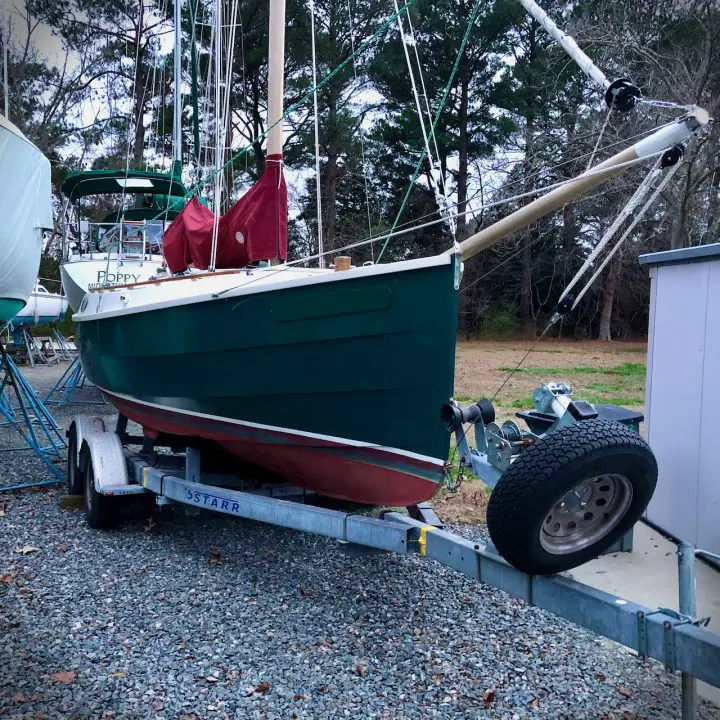
Table of Contents
Best trailerable sailboats, easy to launch trailerable sailboats, quick setup time, towing weight, catalina 22/25 “pop-top”, com-pac horizon cat for classic coastal cruising, marshall sanderling — small, portable, classy, west wight potter 19 — the tiny go-anywhere sailboat, seaward 26rk with retractable lead keel, corsair f-24 trimaran – sporty sailing, macgregor 26m — maximum speed meets maximum living space, long-range cruising boats, 7 best trailerable boats – a recap, what’s the best trailerable sailboat for a cruise, trailerable sailboats faqs.
- Catalina 22/25
- Com-Pac Horizon Cat
- Marshall Sanderling
- West Wight Potter 19
- Seaward 26RK
- Corsair F-24 Trimaran
- MacGregor 26M
| Boat | Pros | Cons |
|---|---|---|
| Catalina 22/25 with Pop-Top | Standing headroom when pop-top extended; Feels much larger than it is; Allows freedom of movement for cooking, changing, etc | Pop-top only provides headroom in small section of boat; Later models lacked this feature |
| Com-Pac Horizon Cat | Well built; Quick-rig system for fast & simple setup; Separate head; Space to lounge | No mention of cons |
| Marshall Sanderling | Easy to sail & tow; Traditional charm; Fiberglass hull; Option for electric motor | Very small for cruising; No galley; Toilet not enclosed |
| West Wight Potter 19 | Reputation for go-anywhere cruiser; Hotplate, sink & porta-potty packed in; Easy setup & towing | Extremely tight quarters; No mention of cons |
| Seaward 26RK | High quality construction; Retractable keel provides stability & shallow draft; Lots of amenities | Heavy – 6,000 lb towing weight |
| Corsair F-24 Trimaran | Very lightweight & easy to tow; Offers adrenaline-pumping performance sailing | Not ideal for offshore/rough conditions |
| MacGregor 26M | Massive interior space; Towable behind most vehicles; Fast powerboat & sailboat capabilities | Not built for offshore use; Not appealing for hardcore sailors |
We’ll get into more detail about each brand in my post today, so hang tight!
What Is a Trailerable Sailboat, Exactly?
For this article, the priorities for a trailerable sailboat are:
- Easy to launch
- Require minimum setup to launch and store
- Lightweight enough to be towed by the average vehicle
Before you can really classify a sailboat as trailerable, you need to evaluate and narrow your search criteria. Truthfully, 50-plus-foot ocean-going sailboats are regularly put on trailers. But that’s done commercially, on a big rig, with special permits for oversized loads, and even led cars.
That probably isn’t what most people mean when they think of a trailerable sailboat. But what is the priority here, the trailerable part or the sailboat part? Compromises are going to have to be made somewhere.
If you’re looking at the 20-foot-and-under sailboat crowd, finding a trailerable example should not be hard. Most sailboats this size are designed for trailers anyway since they aren’t the sort of boats people want to pay to leave in a slip year-round.
Things get more interesting when you look at the 20 to 30-foot boats. In this class, there are stout ocean-going cruisers with deep keels and lightweight centerboard trailer sailboats designed from the get-go to be trailered by the average car or SUV. The differences between these boats are night and day.
Sailboats often have a hard time at boat ramps. First, deep keels mean that the trailer must extend farther into the water than the average boat ramp allows. This means the ramp needs to go back far enough, and the trailer tongue needs to be long enough not to swamp the car.
If you have a boat like this, you’ll need to find the right boat ramps. Unfortunately, not all ramps are created equally. If your boat draws more than two or three feet on the trailer, you’re going to be limited to steep, paved, and high-quality boat ramps. Unfortunately, those aren’t standard features, so your cruising grounds are going to be limited.
Usually, ramps aren’t built steeply because they are often slippery. Your tow vehicle will need excellent traction and torque to pull your fully loaded boat out of a steep ramp. The steeper the ramp, the more trouble you’ll have.
The alternative to finding steep ramps is to use a trailer tongue extender. This lets you get the trailer into deeper water without swamping the tow vehicle. But it also means that the ramp needs to extend deep enough. Many ramps end abruptly. Allowing your trailer to sink off the edge is an excellent way to get stuck or pop a tire.
Pick a boat as easy to launch and retrieve as a similarly sized powerboat to remove all of these boat ramp problems. The soft chines of most sailboats will always require a little more water, but a swing keel and the hinged rudder raised mean that the boat can sit low on the trailer bunks. That way, you only need one or two feet of water to launch, an easy feat at nearly every boat ramp you can find.
The next consideration for a sailboat to be portable enough to call it “trailerable” is the amount of time it takes to step the mast and get it ready to cruise.
To accomplish this, you need a mast that can be stepped by a two-person team–maximum. Ideally, it will have some tabernacle hardware to enable one person to do the task for solo sailing.
There is an entire family of pocket cruisers that could ideally fit on trailers. But you won’t find the Fickas or the Falmouth cutters on my list, simply because they aren’t easy to launch or easy to rig. But, of course, they’re also too heavy for most vehicles to tow, which leads us to the final point of excluding them this trailable pocket cruiser’s list.
One of the most significant financial burdens the trailer sailer faces is their tow vehicle. You are all set if you already drive a two-ton dually diesel pickup truck. But if your daily driver is an SUV or light pickup, you need to think long and hard about the math of the towing equation.
Whatever boat you buy cannot exceed the towing rating limits of your tow vehicle. If you don’t have a tow vehicle, you’ll need to buy one. This will double or triple the cost of getting a trailer sailer in most cases. For the same money, you may want to look at a boat that stays in the water at a traditional boat slip. For the cost of a trailer sailer and a tow vehicle, you can probably step into a nice boat that is larger and more comfortable than any towable.
If you have a tow vehicle, you need a light enough vessel for it to tow. Most modern SUVs tow less than 2,500 pounds. Anything more than 5,000 will require a full-size pickup. Remember that the tow weight isn’t just the boat’s displacement—it’s the empty hull weight, plus the weight of the trailer and any extra gear you need to pack into the boat.
Finding a vessel that fits these limitations on weight isn’t easy. If the manufacturer’s goal is to make it towable, immediate limits are placed on the materials they can use. This means less seaworthiness since boats are built light and thin. As far as stability goes, lead keels are generally out, and water ballast systems or centerboards might be used instead. It doesn’t mean these boats aren’t safe and fun, but they aren’t designed for rough conditions, crossing oceans, or living on in the water full-time .
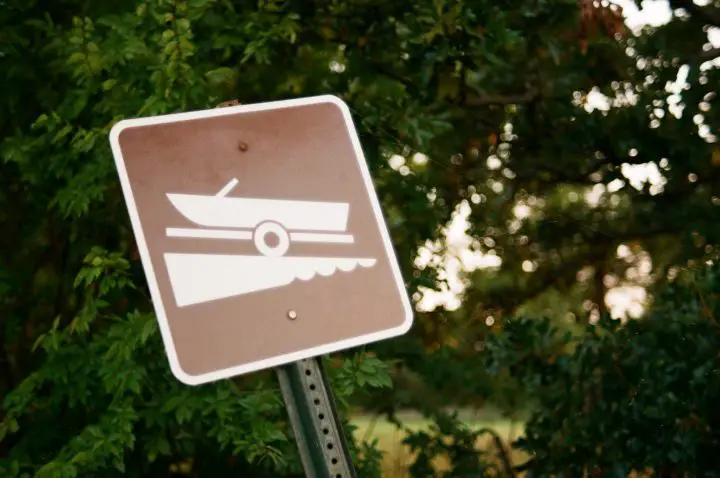
7 Best Trailerable Cruising Sailboats
There are more trailerable sailboats out there than you might imagine. Here’s a look at seven popular options of all shapes and sizes to give you a taste of what you might want to take to sea.
The boats here are selected for their storage and living space. With these boats and a little outfitting, you can spend weeks gunk-holing in the Chesapeake Bay or island hopping the Bahamas. If you broaden your scope to include daysailers with no cabin space, there are countless more options.
One of the worst parts of a small trailerable sailboat or pocket cruiser is the lack of stand-up headroom. One clever solution that you’ll find on some weekend sailboat types is the pop-top.
The pop-top is simply an area around the companionway hatch that extends upward on struts. So when you’re at the dock or anchor, you get standing headroom down below—at least right inside the pop-top.
You can build a canvas enclosure for your pop-top to use it in all weather. A pop-top makes your boat feel much larger than it is and allows you to move freely to cook or get changed down below or even do a nice boat bed area.
Later models of the Catalina Sport 22 and Capri 22s lacked this cool pop-top feature, so if you want it, you’ll need to seek out an older model on the used market.
Com-Pac has been building small sailboats since the early 1970s. They currently sell two lines, each with various-sized boats. All are well built, and a majority of their boats are trailerable.
Most interesting at the Com-Pac traditional catboats . The rigging is more straightforward than modern sloops, with only one large mainsail. Com-Pac boats come with a unique quick-rig system to make getting on the water fast and simple.
The Horizon Cat Coastal Cruising has a displacement of 2,500 pounds with a 2’2″ draft when the board is up. She has a separate head forward and space to lounge either topside or down below. The smaller Sun Cat has slightly few amenities but shaves off a few feet and pounds, making it easier to tow and it is one of these amazing small sailboats. Com-Pacs features stub keels, so their centerboard and hinged rudder do not take up space in the cabin.
On the sloop rig side, the Com-Pac 23 comes in a 3,000-pound traditional sailboat or a very interesting pilothouse. Both are incredibly livable for their size , with shallow two-foot-long fixed keels and high-quality construction.
Another option if you like catboats is the Marshall Sanderling. This salty 18-footer oozes traditional charm , all while being easy to sail and easier to tow. And while she has wooden boat lines, she has a modern laminated fiberglass hull.
The Sanderling has a 2,200-pound displacement, so tow weights will be around 3,000 pounds. At only 18-feet, she’s on the small side for cruising. The cuddy cabin has no galley, and the portable toilet is not enclosed. But that small size means a simple boat that’s easy to maintain and take anywhere.
An electric motor package is an exciting option on this weekend sailboat!
View this post on Instagram A post shared by @marshallmarinecat
You can’t mention tiny trailer sailers without touching on the famous West Wight Potter . These 15 and 19-foot pocket cruisers have earned a worldwide reputation as the ultimate go-anywhere coastal cruiser.
The West Wight Potter 19 offers the most living space for staying aboard and cruising. So even though its dimensions are diminutive, this little boat packs a lot in. There’s a single burner hotplate and sink and a porta-potty tucked under a cushion. Yes, it’s tight—but the company claims the little boat can sleep five people. Any more than two will feel pretty crowded, however.
The boat comes standard with a mast-raising system that a single person can manage alone. It has a daggerboard for a shallow draft of a half-foot when the board is up. The total towing weight is around 1,500 pounds, which means nearly any car can tow a West Wight Potter.
This little-known trailer sailer is produced at the same Florida factory that makes Island Packet Yachts. That should give you a little bit of an idea of what sort of boat it is—trailerable, yes, but also high-quality, beautiful, and built for cruising. In other words, it’s one of the nicest all round pocket cruisers and it feels like a much larger boat.
The Seaward is easily the saltiest boat on this list . It’s beefy and seaworthy. Instead of a lightweight centerboard, Seaward fits the RK with a bulb-shaped retracting keel. Other big-boat items include a Yanmar diesel inboard motor and an enclosed head. The spacious cabin of the boat features a double berth and is ready for salt water cruising.
According to sailboatdata.com , the tow weight of the 26RK is 6,000 pounds. With the keel up, the draft is 1.25 feet.
Multihull sailors need not feel left out from the trailer sailer club and the pocket cruiser. Beyond the ubiquitous beach Hobie Cat, there are not many options for catamarans. But trimarans are uniquely suited to be towed.
Why? For one thing, performance oriented boats like trimarans are based on it being built light. There is no ballast—a trimaran’s stability comes from its two outer hulls. Additionally, the living space is entirely housed in the central hull–the outer floats are small and sometimes foldable. Finally, there are no keels on tris, so they are extremely shallow draft and perfect for trailering.
If you’re looking for adrenaline-pumping sporty and fun sailing, it’s impossible to beat what a trimaran will offer. Let’s not beat around the bush—most of the trailer sailers on this list have hull speeds around five knots. The Corsair has no such limits, routinely sailing at 15 knots or more .
The new Corsair 880 trimaran has an unloaded weight of 3,659 pounds. It is trailerable behind a big SUV or small pickup and is probably the most fun sailing option that is trailerable at all.
An even more portable option is the older Corsair F-24. It has a light displacement of under 2,000 pounds—so nearly any SUV can tow it.
MacGregor owns the market on trailerable motor sailers since they more or less created the product to fit the bill. The MacGregor 26 is not like other boats. The design combines a planing powerboat with a centerboard sailboat. Imagine scooting along at 20 knots or more when the wind is down or enjoying a sporty sail on a breezy day–in the same boat.
The entire boat is built from the ground up for towing and long-range sailing. So if you want a big sailboat that you can tow behind pretty much any SUV, the MacGregor has to be on your list.
Depending on the model, the 26-foot-long boats have incredibly light dry weights of between 1,650 and 2,350 pounds. Considering the massive volume of the roomy cabin, the ability to tow such a large vessel opens up an entire world of opportunities for owners.
It’s not all good news, of course. MacGregor owners love their boats, but they are built light and are not ideally suited for offshore cruising or rough weather. But in bays and for coastal sailing on nice days, few boats can get as much use as a MacGregor.
The motorboat capability of the 26M and 26X might not appeal to hardcore sailors, but for those looking to maximize their use of the boat depending on the weather, their mood, or location, it makes a lot of sense.
MacGregor shut down in 2015, but the daughter and son-in-law of the original owners took over production and renamed the boat the Tattoo 26 . The company will soon release a smaller version, the Tattoo 22 .
If the 26 is a bit big to make your list of best trailerable small sailboats, consider the smaller Powersailer 19. It’s nearly identical to the 26, just smaller and lighter.
View this post on Instagram A post shared by Dale Roddick (@droddick33)
What Do You Want Your Trailer Sailer To Do?
After you’ve settled on how you will tow and launch your trailer sailer, now it’s time to dream about what you want it to do. Where will it take you?
The beauty of a towable boat is that you can travel anywhere. A boat in the water might take weeks or months to move a few hundred miles. But if you can attach it to your car and do 65 mph on the interstate, you could sail on the Pacific on Monday, the Gulf of Mexico on Wednesday, and the Atlantic on Friday.
We can divide our trailerable sailboats into three groups – daysailers, weekenders, and cruisers.
These are designed with open cockpits and no space to sleep. This is a majority of the sub-22-foot boats on the market. They are designed to be launched, play for the day, and return to the ramp or dock.
A weekender will have rudimentary sleeping facilities. Think of it as a floating tent—it’s not a five-star hotel, but you can sleep under the stars or get out of the rain. Conceivably you could stay aboard indefinitely, but it doesn’t have much room for gear. So most people are ready to get off after a day or two.
A cruising boat has sleeping, cooking, and toilet facilities built-in. These might be small and simple, but in any quantity, they mean you can disconnect from shore for a long time. Unfortunately, squeezing all of this into a tow-friendly package isn’t easy, and very few boats do it well.
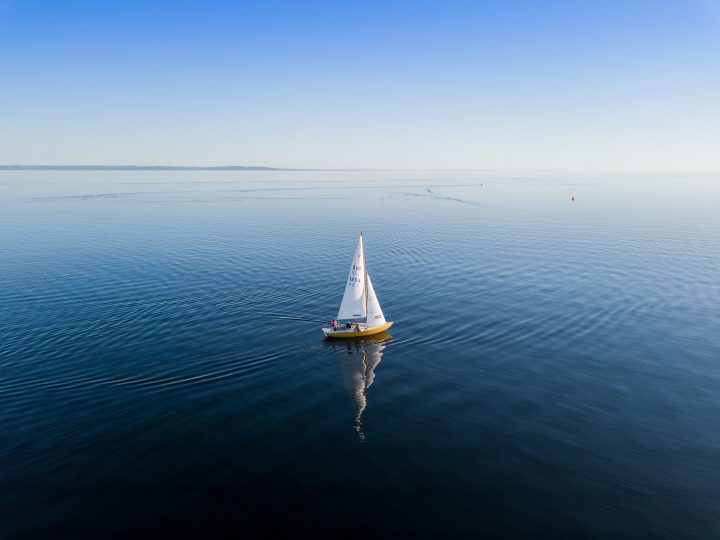
| Boat | Advantages |
|---|---|
| Catalina 22/25 “Pop-Top” | – Standing headroom below deck – Feels much larger than it is – Freedom to move below deck |
| Com-Pac Horizon Cat | – Simple catboat rigging – Quick-rig system – Shallow 2′ draft – Quality construction |
| Marshall Sanderling | – Traditional charm – Easy to maintain – Electric motor option |
| West Wight Potter 19 | – Go anywhere reputation – Packs in amenities – Towable by any vehicle |
| Seaward 26RK | – Quality construction – Big boat features – Retractable keel |
| Corsair F-24 Trimaran | – Very light/easy to tow – Shallow draft – Fast performance |
| MacGregor 26M | – Massive interior space – Planing hull enables speed – Towable by most SUVs |
The best trailer sailor for your adventures will depend on many factors. Like any boat, whatever you decide on will be a compromise – boats always are. But there are plenty of choices out there, no matter what size your tow vehicle is and no matter what sailing adventures you have in mind.
What size sailboat is trailerable?
Even large yachts are routinely transported by towing across land, so the question is more of how big a sailboat can you tow? Your tow vehicle will be the limiting factor. The upper limit for most large SUVs and trucks is usually a sailboat around 26 feet long.
Sailboats are generally very heavily built, with ballast and lead keels. Sailboats specifically made to be trailer sailers are lighter. They may use drainable water ballast tanks instead of fixed ballast and have fewer fixtures and amenities.
To find the best trailer sailer, you need to balance the total tow weight, the ease of rig setup at the boat ramp, and the boat’s draft. Shallow draft boats with centerboards are the easiest to launch and retrieve.
Is a Hunter 27 trailerable?
No. The Hunter 27 is a one of those fixed-keel larger boats built from 1974 to 1984. The boat’s displacement is 7,000 pounds, not including trailer and gear. That alone makes it too heavy to tow by all but the beefiest diesel trucks.
Furthermore, the fixed keels had drafts between 3.25 and 5 feet, all of which are too much for most boat ramps. In short, the standard Hunter Marine 27 is too big to tow for most people.
On the other hand, Hunter has made several good trailer sailers over the years. For example, the Hunter 240 and 260 were explicitly designed for trailering. They have drainable water ballast and shallow keel/centerboard drafts less than two feet.
Is a Catalina 22 trailerable?
Yes, the Catalina 22 is easily trailerable and makes a wonderful weekend sailboat. In fact, there were over 15,000 Catalina 22s made and sold over the years.
The boat’s displacement is 2,250 pounds, which means your total tow weight with trailer and gear will be under 3,000 pounds. This is within the capabilities of most mid to full-size SUVs and light trucks. Be sure to check your vehicle’s towing capacity, of course.
The centerboard on the Catalina 22 is another factor in its easy towing. With the board up, the boat draws only two feet. This makes it easy to float off the trailer at nearly any boat ramp. You should avoid fixed keel versions of the 22 for towing unless you have access to extra deep ramps.
Matt has been boating around Florida for over 25 years in everything from small powerboats to large cruising catamarans. He currently lives aboard a 38-foot Cabo Rico sailboat with his wife Lucy and adventure dog Chelsea. Together, they cruise between winters in The Bahamas and summers in the Chesapeake Bay.
Can someone tell me why no other manufacturer makes pop tops? Those who have them, love them. Makes sense for head space with a trailerable boat too. Catalina stopped making them decades ago, yet people still swear by them. So, why isn’t there any newer models?
MacGregor put pop tops on many of its trailerables
Leave a comment
Your email address will not be published. Required fields are marked *
Save my name, email, and website in this browser for the next time I comment.

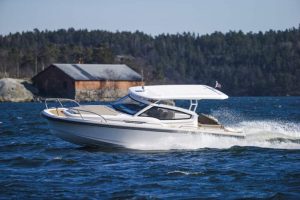
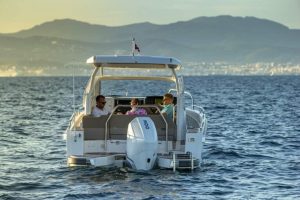
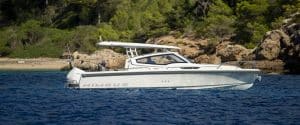
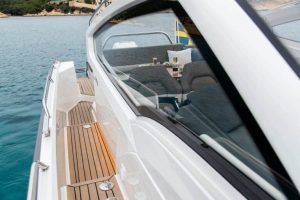

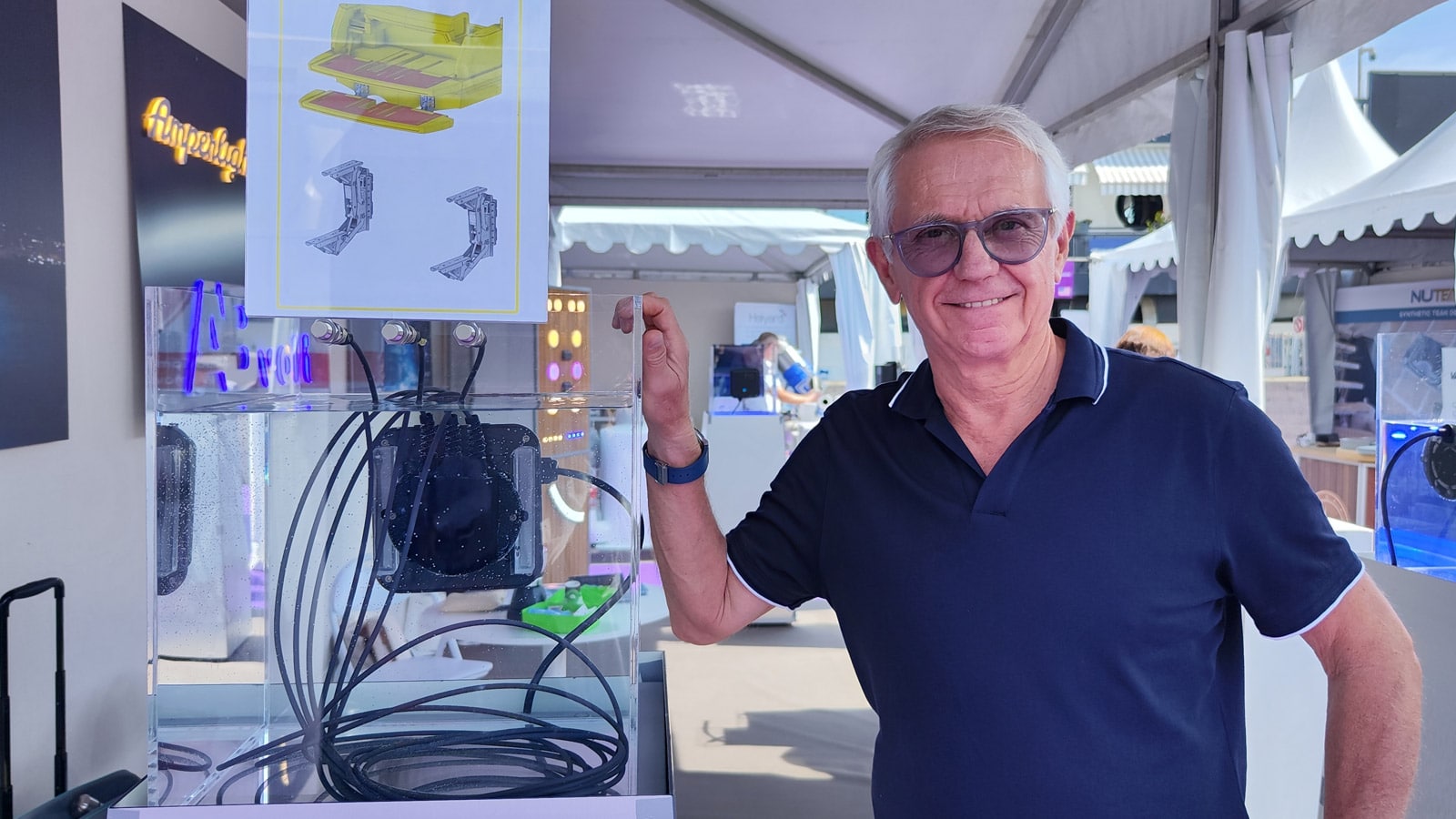
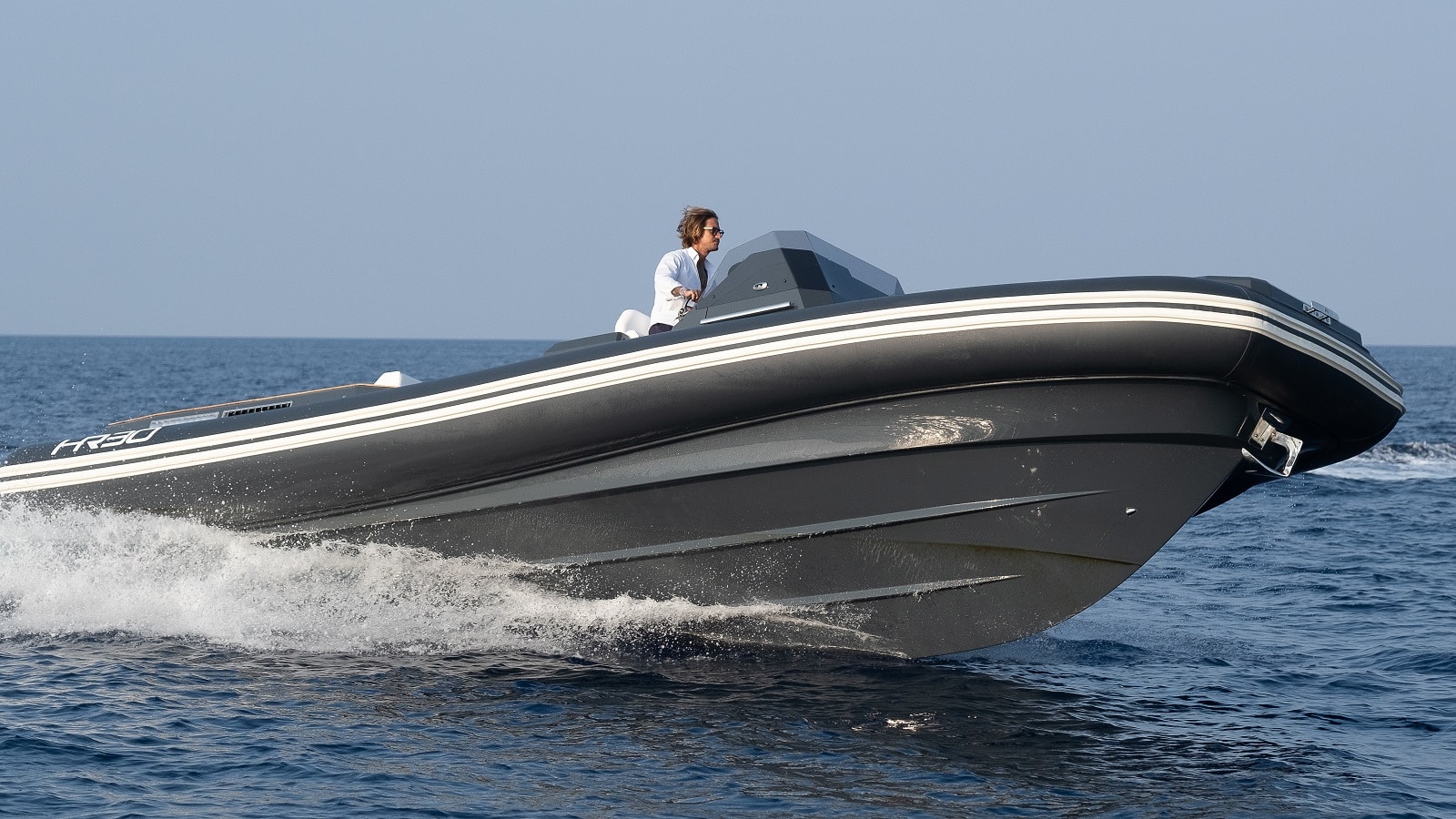
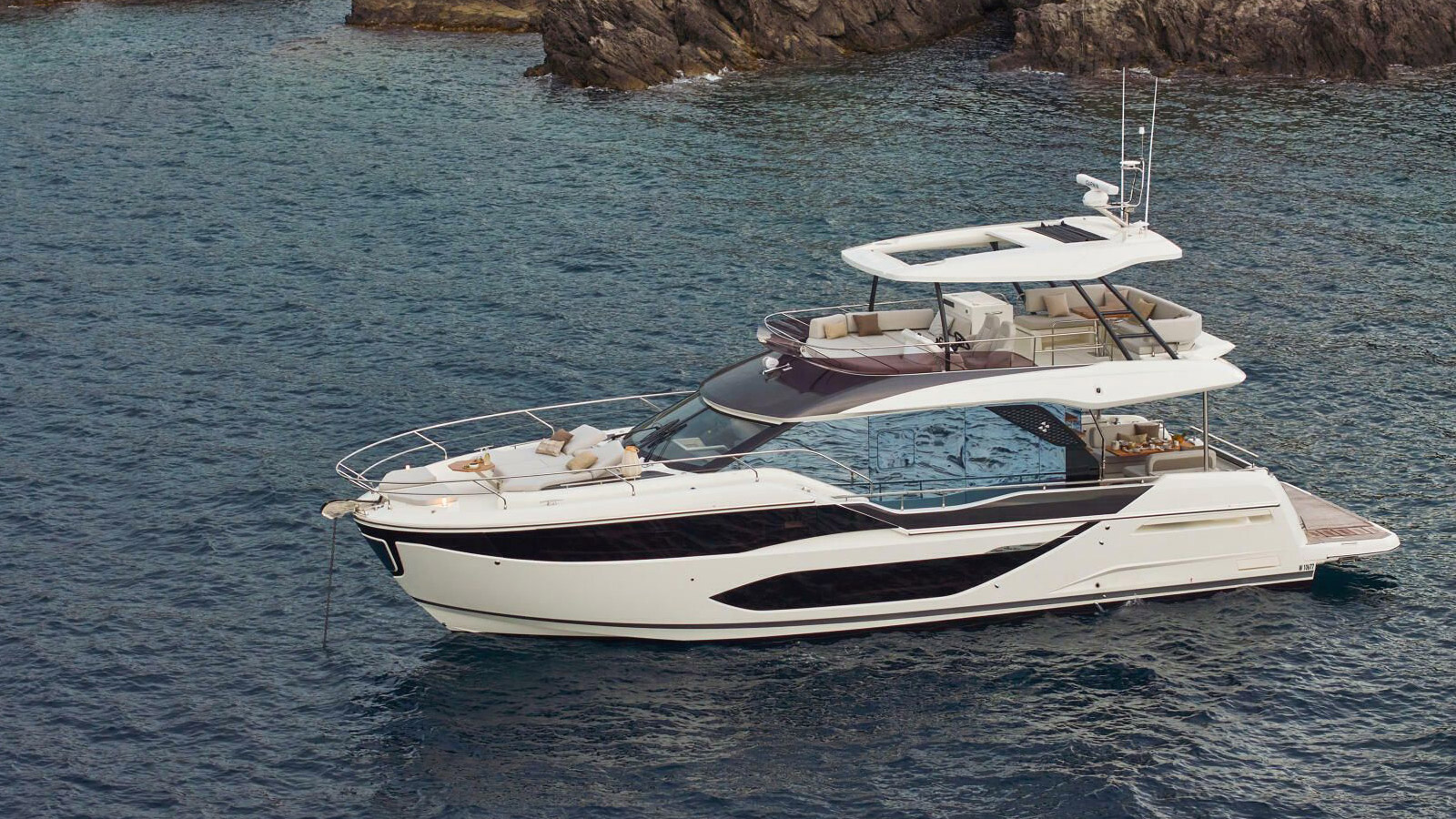
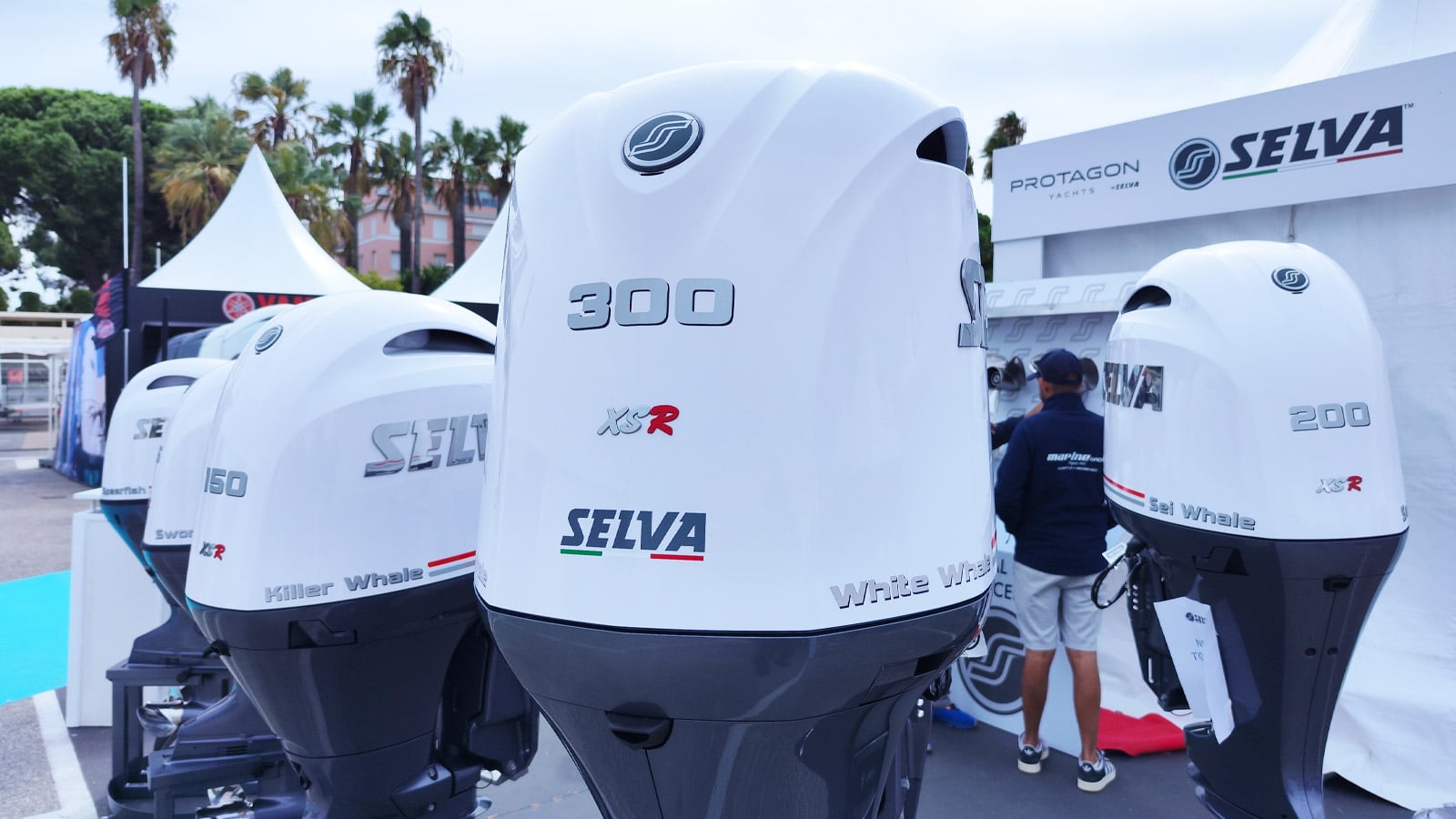






















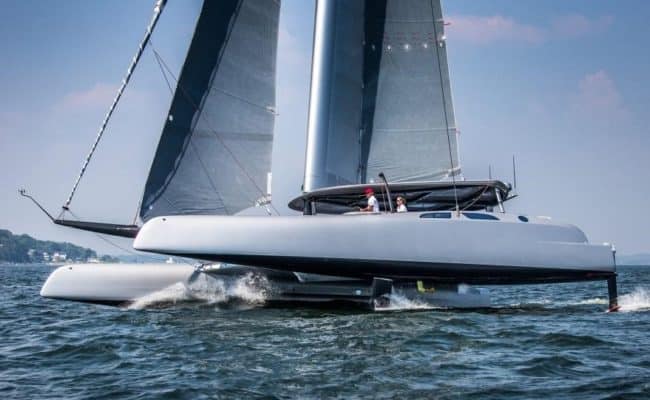
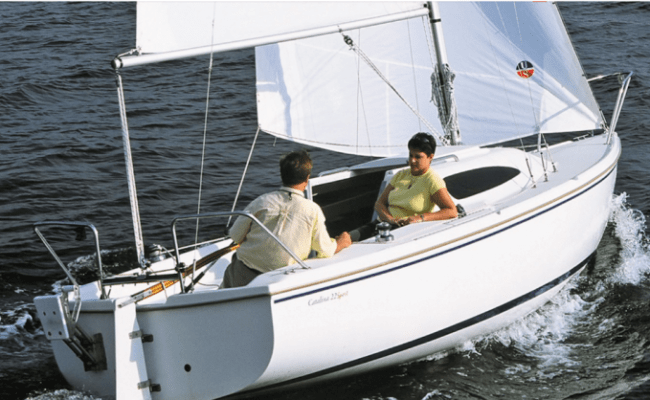
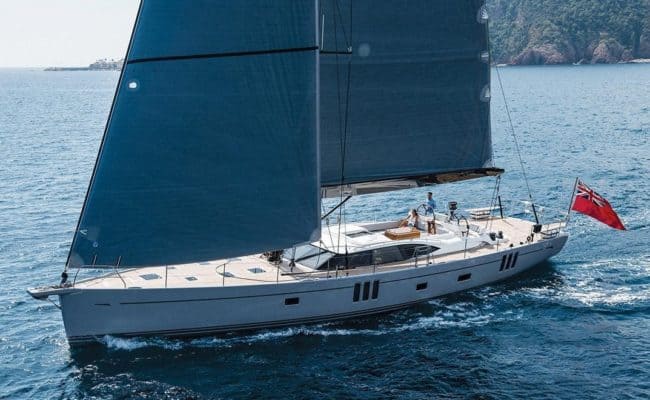
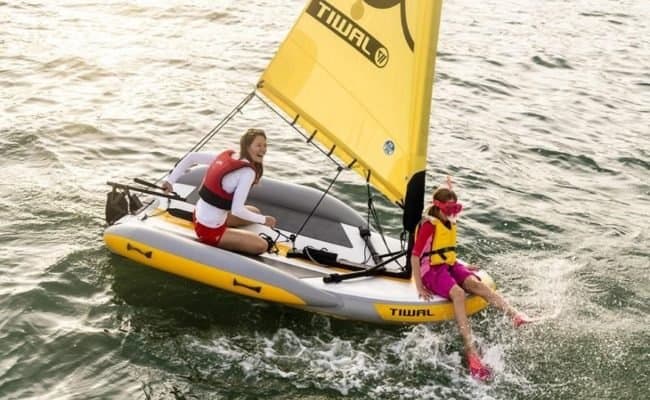
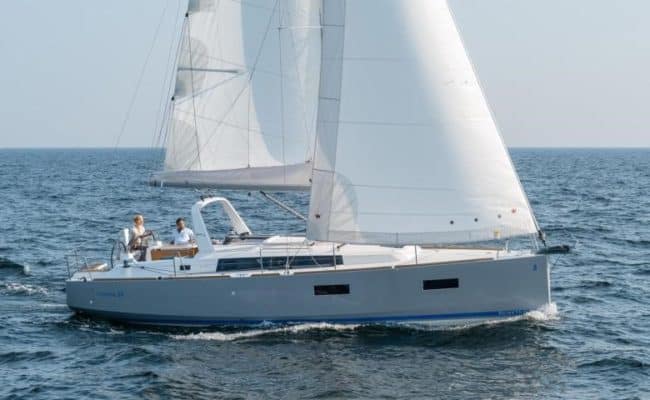

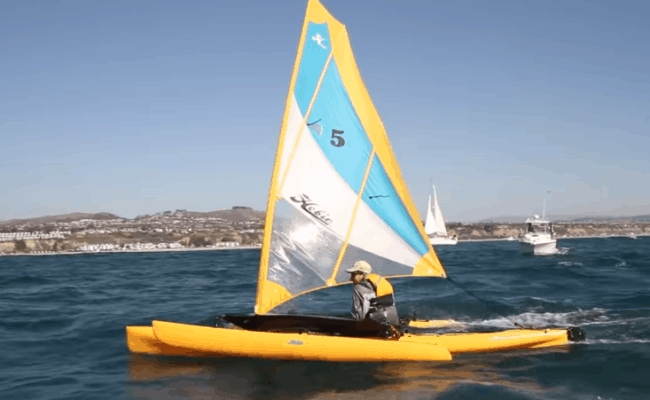
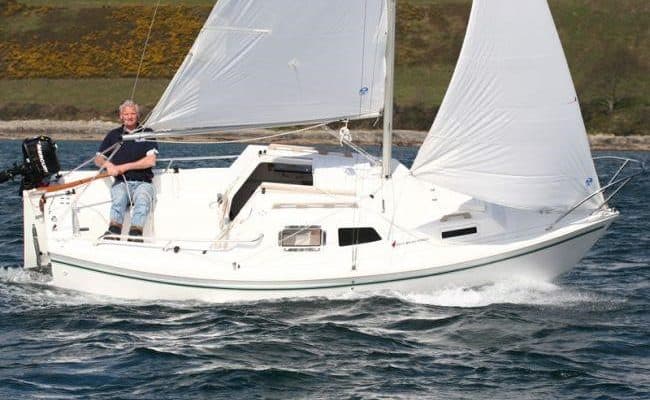
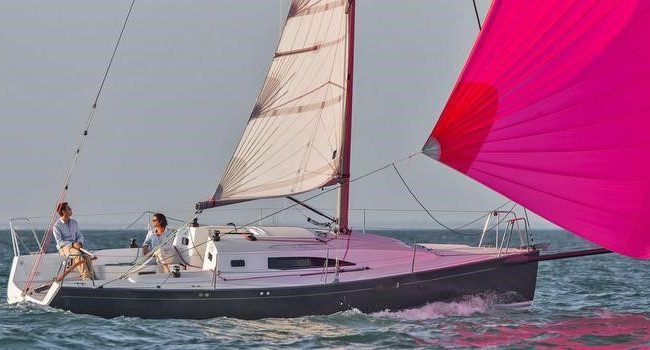









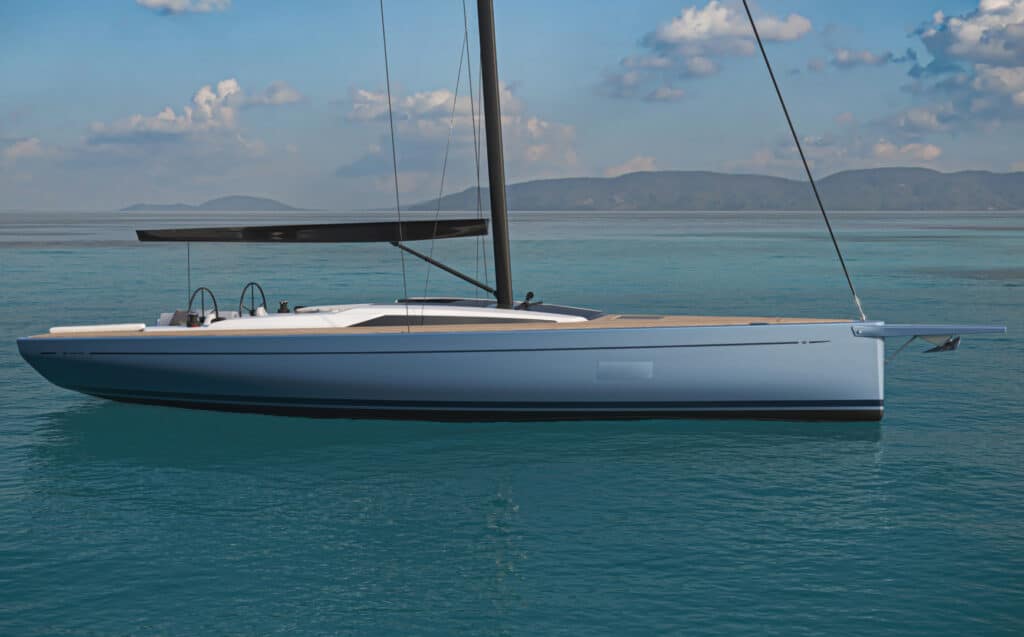
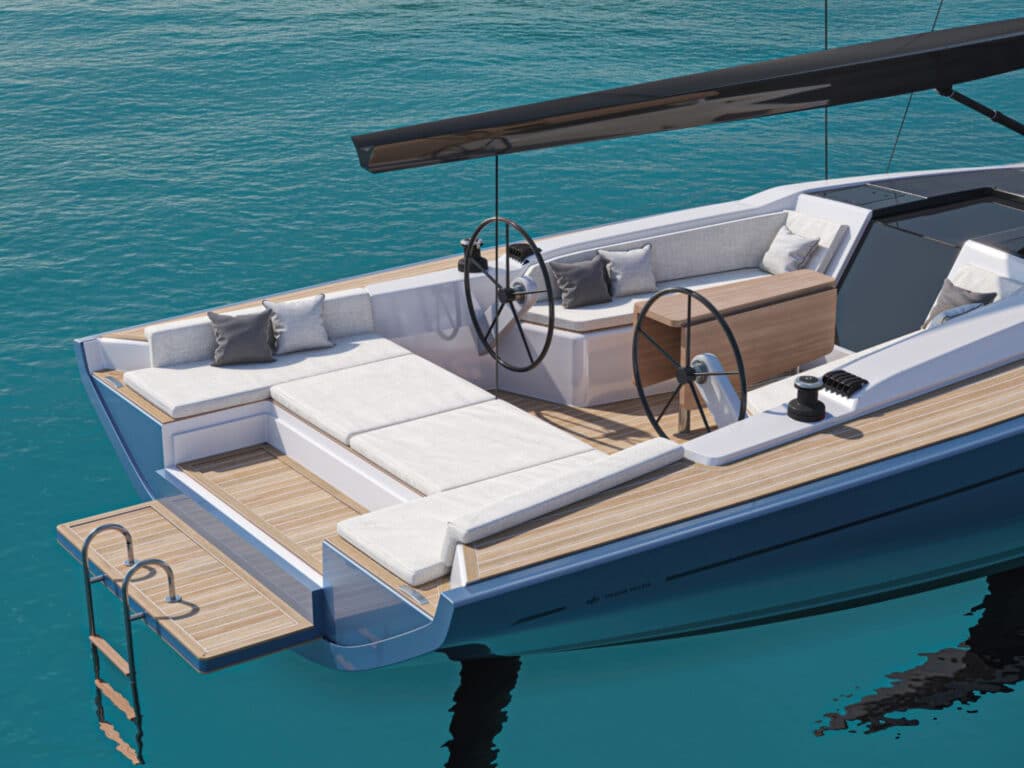
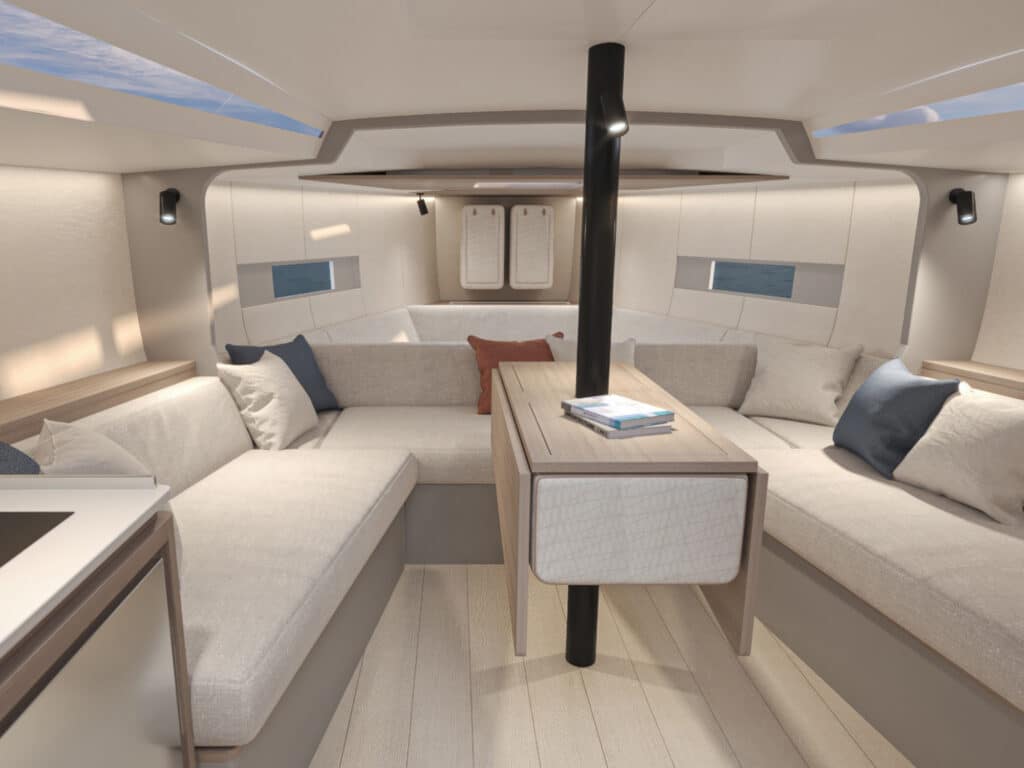
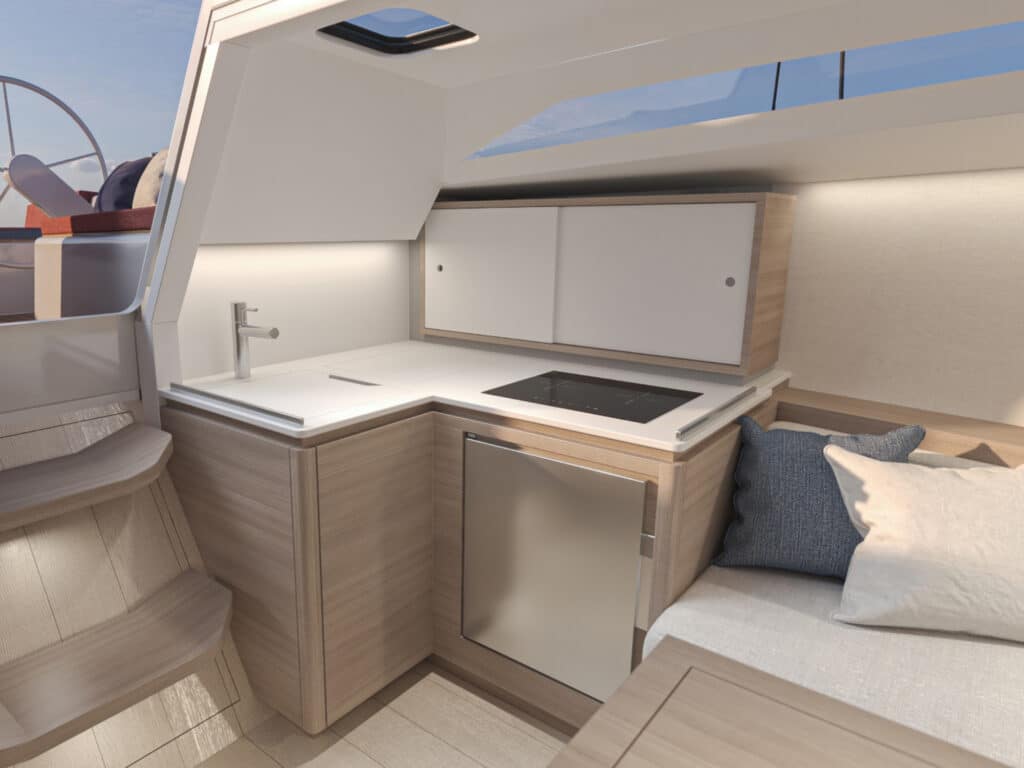




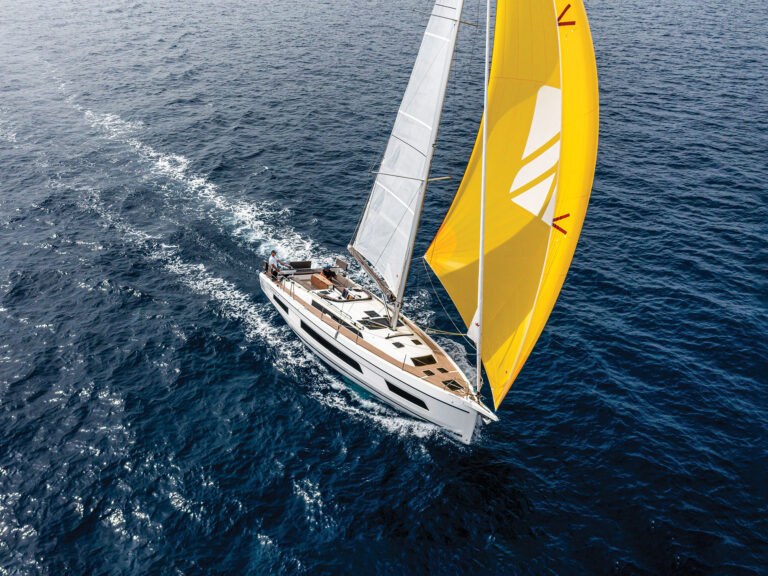
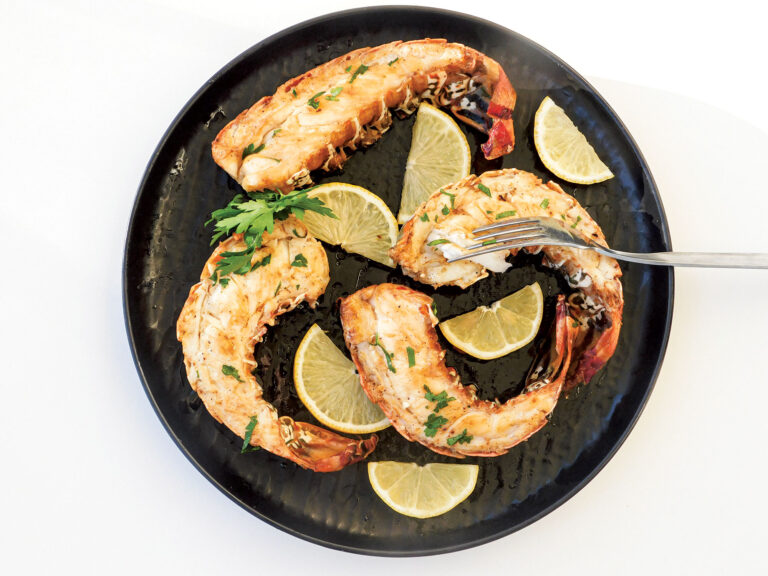
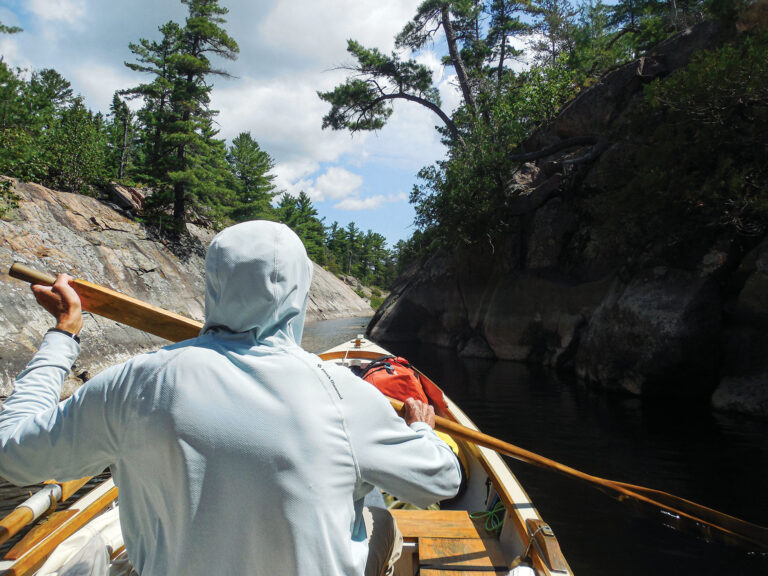
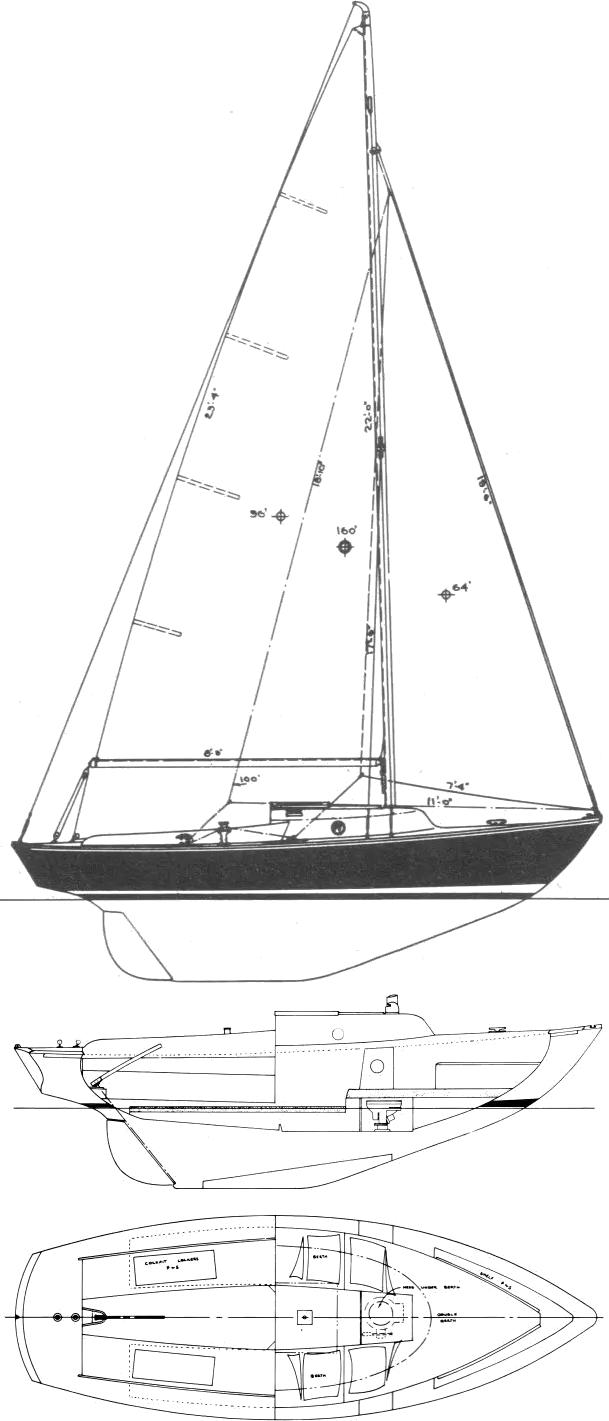
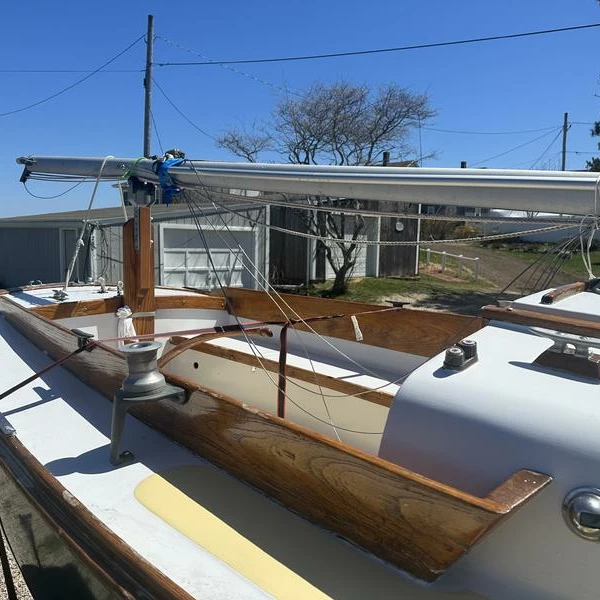

IMAGES
VIDEO
COMMENTS
T he Weekender is a plywood gaff-sloop pocket yacht designed by Peter Stevenson and first presented to the public in a two-page article in the March 1981 issue of Popular Science magazine. In the decades that have followed, it has been a very popular design. I was drawn to its classic look and simple construction. Eager to learn how to sail—and to find out if my wife would enjoy sailing too ...
The Weekender has been our most popular boat design for many years, and we understand why: It has a Classic Style, based loosely on the amazginly pretty Friendship Sloops of New England, and the Weekender is a perfect size for "simply messing about in boats"! ... Small Boats Magazine recently published a very thourough review of our Weekender ...
The boat is designed with positive flotation and offers good load-carrying capacity, which you could put to use if you added the available canvas work and camping tent. NorseBoats offers a smaller sibling, the 12.5, as well; both are available in kit form. $19,000, (902) 659-2790, norseboat.com.
Instead of docking a large boat, you can purchase a small trailerable sailboat. ... The design has been around for over 40 years, and it's served weekender and cruising sailor alike. The Islander 24 is a well-rounded cruising vessel with a spacious cabin for two (or more). The cabin features a forward vee berth, space for a head, and tables ...
11-21-2008, 06:32 PM. Re: Concensus on Stevenson's Projects Vacationer and/or Weekender. I guy around here built one, sailed it once, was hugely disappointed, left it on its trailer for a long time (rotting), then tried to sell it for $5K. He ended up donating it to a charity auction where it was bought by a local boat builder for $100 who put ...
7 Best Trailerable Cruising Sailboats. Catalina 22/25 "Pop-Top". Com-Pac Horizon Cat for Classic Coastal Cruising. Marshall Sanderling — Small, Portable, Classy. West Wight Potter 19 — The Tiny Go-Anywhere Sailboat. Seaward 26RK with Retractable Lead Keel. Corsair F-24 Trimaran - Sporty Sailing.
There was some precedent for this. Bob Butler, who had already built two Weekenders, built a third Weekender as an open boat, and created my dreamboat. Since the Weekender has no centerboard case (it has a keelson that runs the length of the boat), and is flat bottomed, the flat sole makes every inch of the layout usable.
The WEEKENDER model has a slightly larger sail area than the DAYSAILER. Self-bailing cockpit. Also a cuddy cabin with v-berth and two quarter berths. ... 1997), states that a boat with a BN of less than 1.3 will be slow in light winds. A boat with a BN of 1.6 or greater is a boat that will be reefed often in offshore cruising. Derek Harvey ...
Learn more about this boat in our March 2020 Issue of Small Boats Magazine: https://smallboatsmonthly.com/article/weekender/Subscribe: https://smallboatsmont...
October 7, 2022. Nimbus W9: the all-season weekender. Nimbus has always offered excellent, multi-purpose boats, and this time it seems to have outdone itself. With the W9, the Scandinavian yard offers a compact weekender that still provides all the comforts for a day trip and, why not, for a few more days. In fact, this 9-metre boat, in the ...
The yard believes there is more of a market in luxurious dayboats and weekenders than basic small cruising yachts. It takes many of its cues from the 32.1 and aims for much the same concept - that of being a boat that's easy to sail, with decent sailing performance and large, open spaces for sailing and socialising despite its diminutive size.
Sea Sprite 23 (Weekender) is a 22′ 6″ / 6.9 m monohull sailboat designed by Carl Alberg and built by Sailstar Boat Co., Beetle Boat Co.(USA), and C. E. Ryder starting in 1958. ... The WEEKENDER has a self-bailing cockpit, the seats are molded in fiberglass, there is a companionway and stairs down into the cabin, the mast is stepped forward ...
Review of Weekender. Basic specs. The Weekender is a sailboat designed by the American maritime architect bureau Sparkman & Stephens in the late thirties. Less than 100 boats have been produced. The Weekender is built by the American yard George Lawley.
Building a boat is great and fun and very cool and I highly encourage you to do it (and also maybe buy a $800 used oday 14 or something to mess with while building your boat) BUT- given the effort that you are going to put into it, I'd probably avoid the stevenson's projects stuff beyond the basic rowing tender plan they have or the "amphora ...
The Stevenson Weekender is a boat that borrows some good ideas from the golden age of working sail, as well as some new wrinkles from space-age materials. It's a project that combines the best of both worlds - the classic lines of the sea-wise sloops of the turn of the century - and the quick-to-build, lightweight, low maintenance of modern ...
The Typhoon is a full keel design with a yacht rather than dinghy like profile and seems larger than she actually is; although, dimensions are a mere 18' 6" LOA, 13' 11" LWL, 6' 3" beam and 2' 7" draft. Displacement is a healthy 1,800 to 2,000 lbs, depending on the model. All Typhoons are solidly constructed of fiberglass cloth and ...
5. B-Yachts B30 / B34. The Brenta B30 is the iconic Italian daysailer. A real looker to keep berthed at your Portofino residence, it has a lightweight carbon/epoxy build and a high ballast ratio ...
COSTS TO DATE: 1) Vacationer Plans and DVD $110. 2) Weekender Plans FREE--stevensons offer a free downgrade in plans if you decide the Vacationer is a bit big to build. 3) Marine Grade Playwood (all sheets) $520 (should not need more) 4) First Lumber Purchase: $656 (this is a big chunk of the wood list-all the pieces 10' more purchased and many ...
The Beneteau Oceanis 38 Weekender is the perfect sailboat for this. It comes with the option of a two/three-cabin plan, fitted galley, helmsman's seats, shower, and an additional inside/outside table. ... In the meantime, if you're in the market for a new pontoon boat, check out our comprehensive review on the 10 best pontoon boats.
Weekender 24 is a 24′ 2″ / 7.4 m monohull sailboat designed by Sparkman & Stephens and built by Tidewater Boats starting in 1965. ... Sail area in square feet, derived by adding the mainsail area to 100% of the foretriangle area (the lateral area above the deck between the mast and the forestay). D: ...
June 27, 2016. As the name suggests, a fast weekender is designed to facilitate one of the most enjoyable marine pursuits there is. It's basically a high-performance sports boat that enables you to sleep on board - and with the emphasis on sporting prowess, the accommodation on offer is rarely lavish. On the contrary, even on a premium ...
Grand Soleil's "recyclable" 33-footer is designed to have zero environmental impact while cruising. Grand Soleil's Blue concept is set to premiere at the 2024 Cannes Yachting Festival. Courtesy Grand Soleil. Grand Soleil Yachts has announced its Blue concept, a 33-foot weekender conceived for sustainability and efficiency underway.
Typhoon 18 (Weekender) is a 18′ 6″ / 5.6 m monohull sailboat designed by Carl Alberg and built by Cape Dory Yachts between 1967 and 1986. ... Sail area in square feet, derived by adding the mainsail area to 100% of the foretriangle area (the lateral area above the deck between the mast and the forestay). D: ...